Intel Launches Raptor Lake at AMD: 24-core i9-13900K Arrives Oct 20 for $589
Intel fires back at AMD's Ryzen 7000

Intel shared specs, pricing, benchmarks, and architectural details for its 13th-Gen Raptor Lake lineup today, touting its flagship Core i9-13900K as the 'world's fastest desktop processor.' The lineup includes three new processors with frequencies that jump up to 5.8 GHz, a new record for the mainstream desktop, and more e-cores, giving Intel the core count lead on the mainstream desktop for the first time since AMD's Ryzen arrived back in 2017. Intel also announced that the 6 GHz version of the Raptor Lake is a limited edition model that will come to market later this year. This will be the first 6 GHz desktop PC chip. [EDIT: We also later spotted an unannounced 34-core chip for workstations demoed on the show floor at InnovatiON 2022.]
Paired with a series of other advances, including bumping up the power consumption on lower-end models and the debut of the new Raptor Cove CPU cores, Intel claims the 13th-Gen Raptor Lake processors deliver up to 15% higher single-threaded performance and 41% more multi-threaded performance than their Alder Lake predecessors. The company also says that gaming performance has improved up to 25% on some titles.
If accurate, that means Raptor Lake will either match or exceed AMD's Ryzen 7000 processors that launched yesterday, with the $699 Ryzen 9 7950X and $299 Ryzen 5 7600X both stealing the performance lead from Intel at their respective price points.
| Row 0 - Cell 0 | Price | Cores / Threads (P+E) | P-Core Base / Boost Clock (GHz) | E-Core Base / Boost Clock (GHz) | Cache (L2/L3) | TDP / PBP / MTP | Memory |
| Core i9-13900K / KF | $589 (K) - $564 (KF) | 24 / 32 (8+16) | 3.0 / 5.8 | 2.2 / 4.3 | 68MB (32+36) | 125W / 253W | DDR4-3200 / DDR5-5600 |
| Core i7-13700K / KF | $409 (K) - $384 (KF) | 16 / 24 (8+8) | 3.4 / 5.4 | 2.5 / 4.2 | 54MB (24+30) | 125W / 253W | DDR4-3200 / DDR5-5600 |
| Core i5-13600K / KF | $319 (K) - $294 (KF) | 14 / 20 (6+8) | 3.5 / 5.1 | 2.6 / 3.9 | 44MB (20+24) | 125W / 181W | DDR4-3200 / DDR5-5600 |
The Raptor Lake K-Series Core i9, i7, and i5 chips come to market on October 20, spanning from the flagship $589 Core-13900K to the $319 Core i5-13600K, but they're just the leading wave: Intel will eventually bring 22 Raptor Lake chips to market for desktop PCs, along with a separate lineup for laptops.
Intel has already announced that Raptor Lake will reach up to 6GHz, but it didn't launch that chip today. Intel confirms that this will be a pricey KS model, but we'll have to wait for more info. Intel's Raptor Lake focuses heavily on performance and now supports faster DDR5-5600 memory while maintaining support for value-option DDR4. Intel also employed a significantly improved 7nm process node and made several architectural advances, including fatter, faster, and smarter caches that significantly improve performance. Additionally, a new thread director baked directly into the new Windows 11 2H22 update will improve thread targeting, and thus improve performance with Raptor's hybrid architecture.
Intel recently announced that it would raise the pricing for its chips due to economic factors. While the company left its Core i9 and i7 pricing the same as we saw with the previous gen, it raised pricing for the Core K-series by $30. Let's take a closer look at the details.
Intel 13th-Gen Raptor Lake Specifications and Pricing
| Row 0 - Cell 0 | Price | Cores / Threads (P+E) | P-Core Base / Boost Clock (GHz) | E-Core Base / Boost Clock (GHz) | Cache (L2/L3) | TDP / PBP / MTP | Memory |
| Core i9-13900K / KF | $589 (K) - $564 (KF) | 24 / 32 (8+16) | 3.0 / 5.8 | 2.2 / 4.3 | 68MB (32+36) | 125W / 253W | DDR4-3200 / DDR5-5600 |
| Ryzen 9 7950X | $699 | 16 / 32 | 4.5 / 5.7 | - | 80MB (16+64) | 170W / 230W | DDR5-5200 |
| Core i9-12900K / KF | $589 (K) - $564 (KF) | 16 / 24 (8+8) | 3.2 / 5.2 | 2.4 / 3.9 | 44MB (14+30) | 125W / 241W | DDR4-3200 / DDR5-4800 |
| Ryzen 9 7900X | $549 | 12 / 24 | 4.7 / 5.6 | - | 76MB (12+64) | 170W / 230W | DDR5-5200 |
| Core i7-13700K / KF | $409 (K) - $384 (KF) | 16 / 24 (8+8) | 3.4 / 5.4 | 2.5 / 4.2 | 54MB (24+30) | 125W / 253W | DDR4-3200 / DDR5-5600 |
| Core i7-12700K / KF | $409 (K) - $384 (KF) | 12 / 20 (8+4) | 3.6 / 5.0 | 2.7 / 3.8 | 37MB (12+25) | 125W / 190W | DDR4-3200 / DDR5-4800 |
| Ryzen 7 7700X | $399 | 8 / 16 | 4.5 / 5.4 | - | 40MB (8+32) | 105W / 142W | DDR5-5200 |
| Ryzen 5 7600X | $299 | 6 / 12 | 4.7 / 5.3 | - | 38MB (6+32) | 105W / 142W | DDR5-5200 |
| Core i5-13600K / KF | $319 (K) - $294 (KF) | 14 / 20 (6+8) | 3.5 / 5.1 | 2.6 / 3.9 | 44MB (20+24) | 125W / 181W | DDR4-3200 / DDR5-5600 |
| Core i5-12600K / KF | $289 (K) - $264 (KF) | 10 / 16 (6+4) | 3.7 / 4.9 | 2.8 / 3.6 | 29.5MB (9.5+20) | 125W / 150W | DDR4-3200 / DDR5-4800 |
| Core i5-13400 / F | ? | 10 / 16 (6+4) | 3.4 / ? | ? | 24MB | 65W / ? | DDR4-3200 / DDR5-5600 |
| Core i5-12400 / F | $199 - $167 (F) | 6 / 12 (4+0) | 4.4 / 2.5 | - | 25.5MB (7.5+18) | 65W / 117W | DDR4-3200 / DDR5-4800 |
As before, Intel's Raptor Lake comes with a mix of both big performance cores (p-cores) for latency-sensitive work and small efficiency cores (e-cores) for threaded and background applications. The e-cores stick with the same Gracemont architecture as before, but the p-cores move from the Golden Cove design to Raptor Cove. As before, you can also opt for graphics-less F-series models to save some cash on the three Raptor Lake chips.
The 24-core Core i9-13900K has the highest clocks of the new chips, with a 600 MHz improvement bringing it to a 5.8 GHz peak. Intel says it's bringing its Thermal Velocity Boost and Adaptive Boost Technology to the Raptor Lake Core i9 models, so the 13900K will have to meet certain temperature and power conditions to reach 5.8 GHz.
While Intel has raised the peak frequencies for both p-cores and e-cores on all Raptor Lake chips, we see a 200 MHz decline in the base clocks. That shouldn't mean much in practical application and is probably done to manage the TDP rating. Speaking of which, the 13900K has the same 125W Base Turbo Power (BTP) as before, but the Maximum Turbo Power (MTP) has increased by 12W and is now 253W.
The Core i9-13900K also has eight more e-cores than its predecessor, delivering much more threaded horsepower. The e-cores also come with a 400 MHz increase to the peak boost, bringing them to 4.3 GHz. Intel says that even though the e-cores use the same Gracemont architecture, changes to the caching policy and a few other fine-grained optimizations (more below) now yield the same IPC and frequency as the original 14nm Skylake cores, but at lower power. Notably, the e-cores give Intel the core count lead on the mainstream desktop PC, as AMD's Ryzen tops out at 16 cores with the 7950X.
Get Tom's Hardware's best news and in-depth reviews, straight to your inbox.
The 24-core $589 Core i9-13900K will square off with AMD's 16-core $699 Ryzen 9 7950X, so Intel could have a pricing advantage if it can match or beat it.
The $409 Core i7-13700K also gets a 400 MHz p-core frequency bump to 5.4 GHz, four more e-cores for a total of eight, and a 400 MHz e-core boost to 4.2 GHz.
Surprisingly, Intel has increased the MTP for this chip to 253W, a 63W increase over the prior gen. The 13700K contends with the $399 Ryzen 7 7700X.

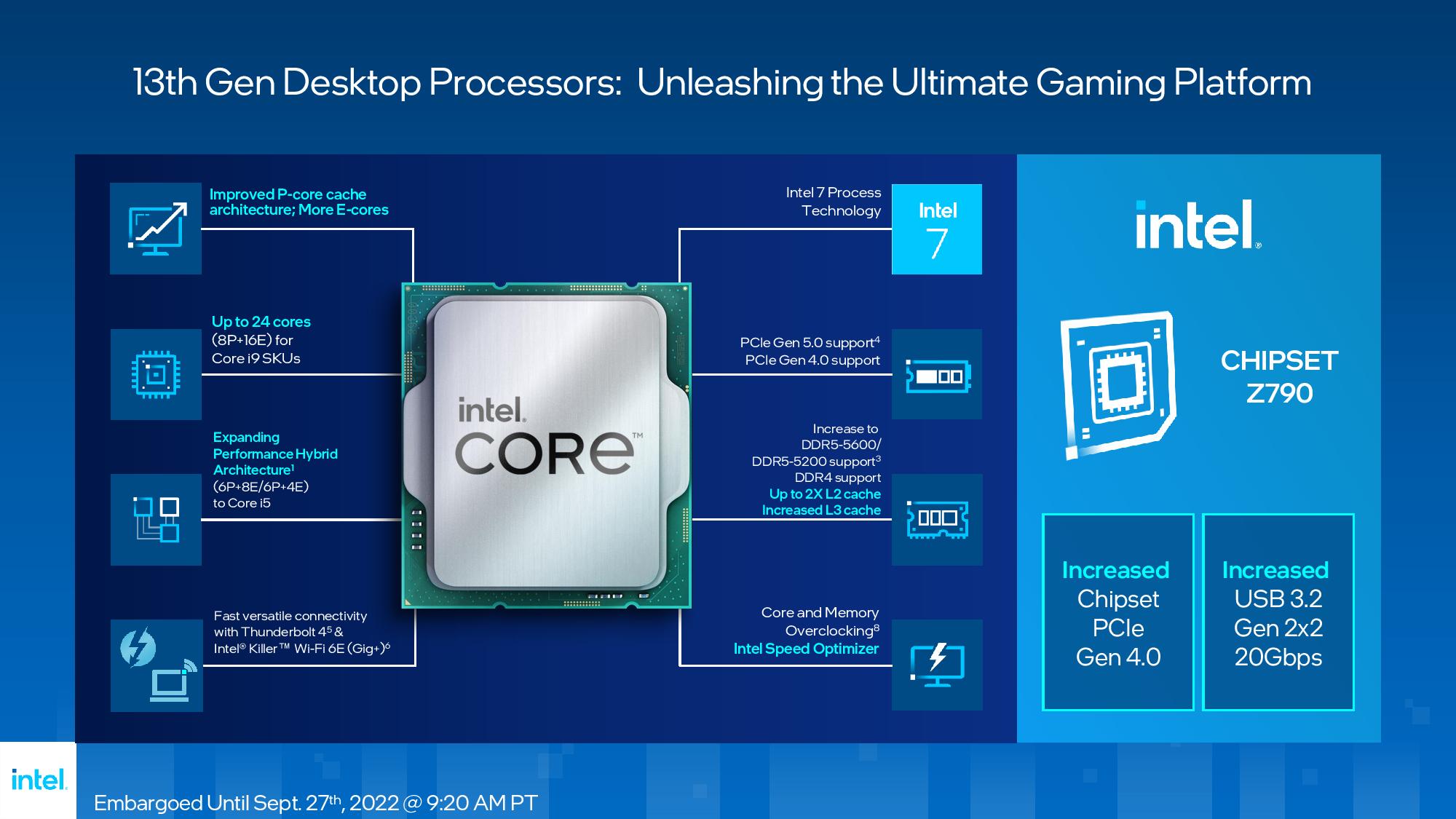
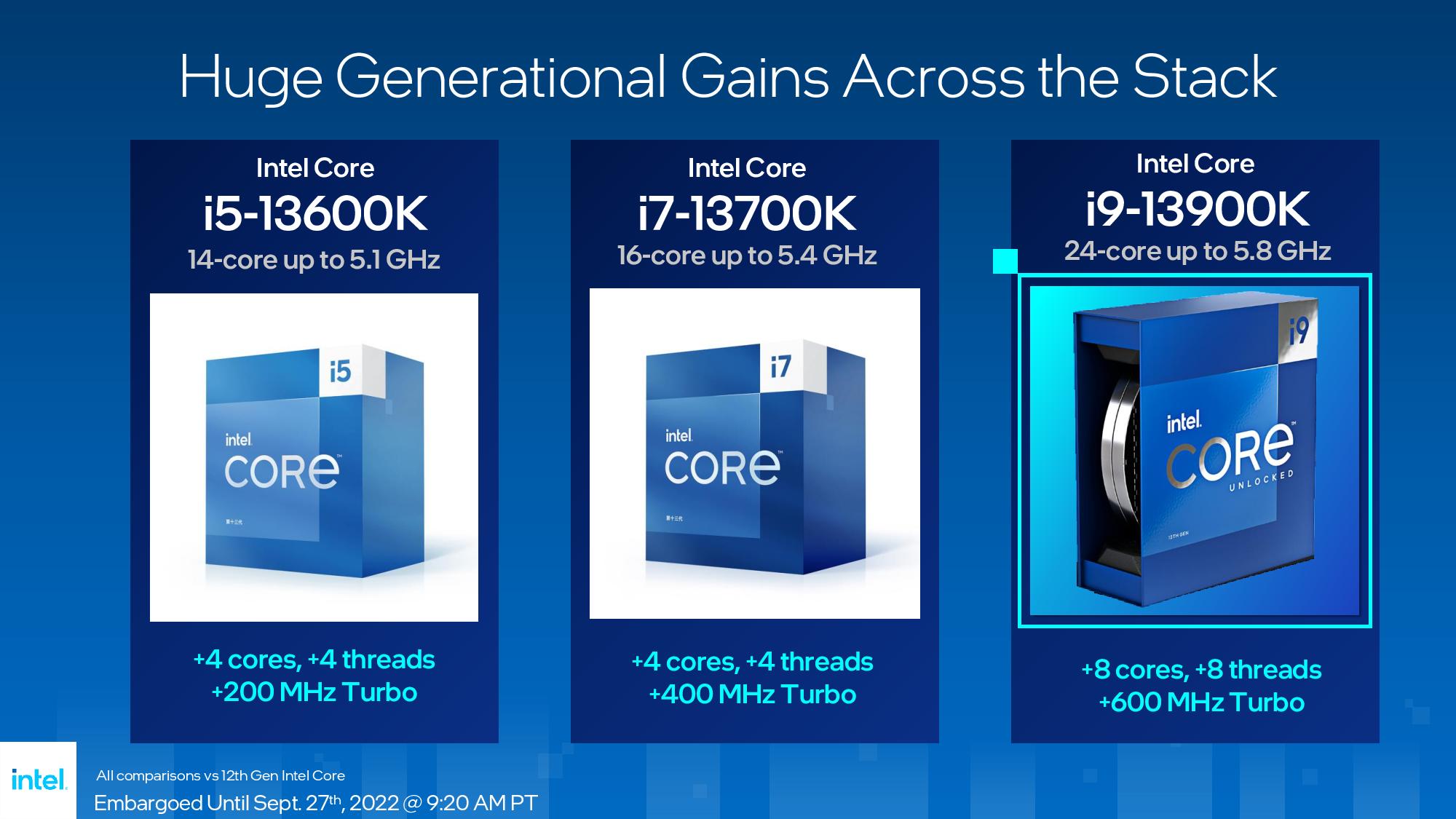
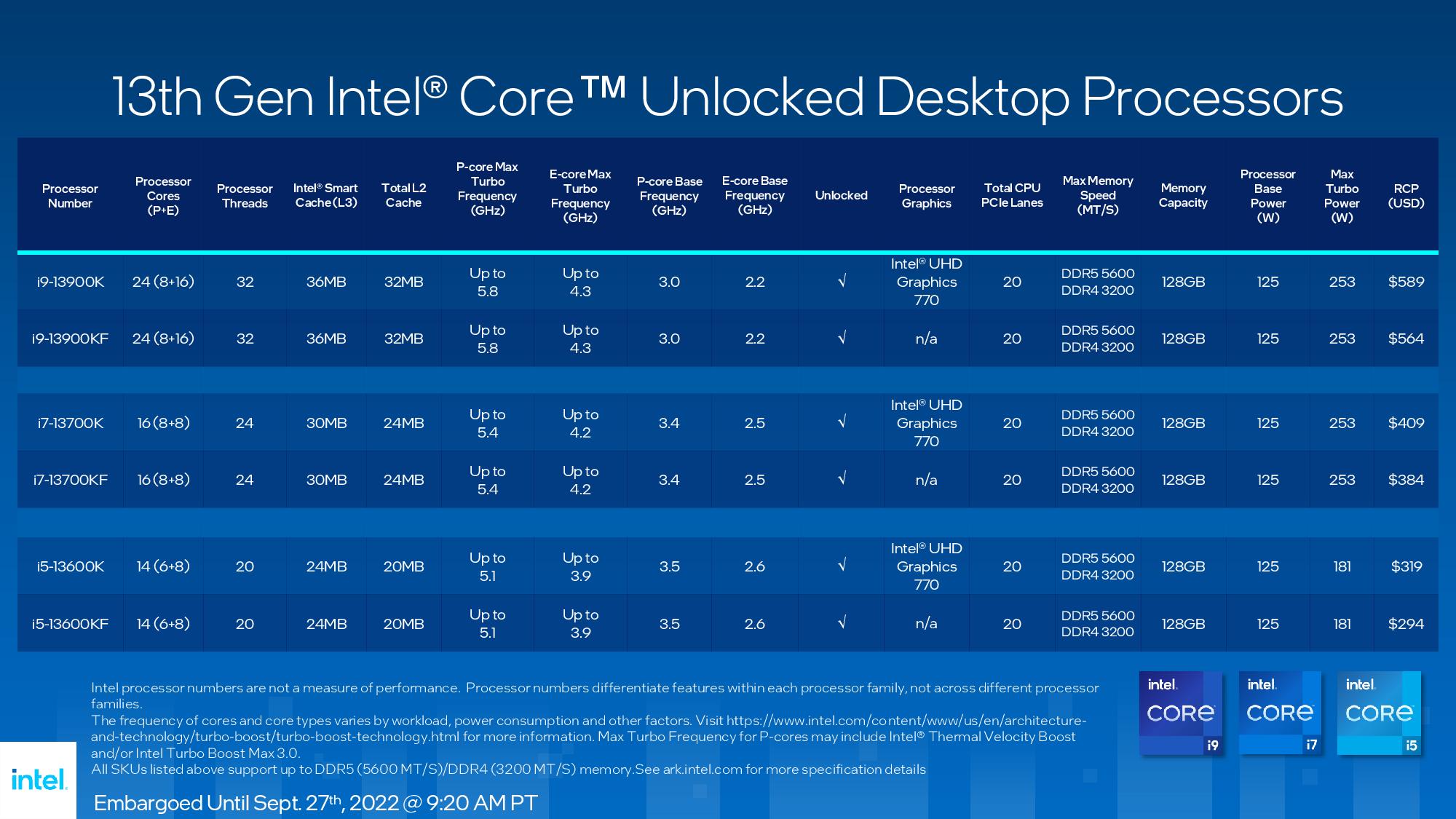
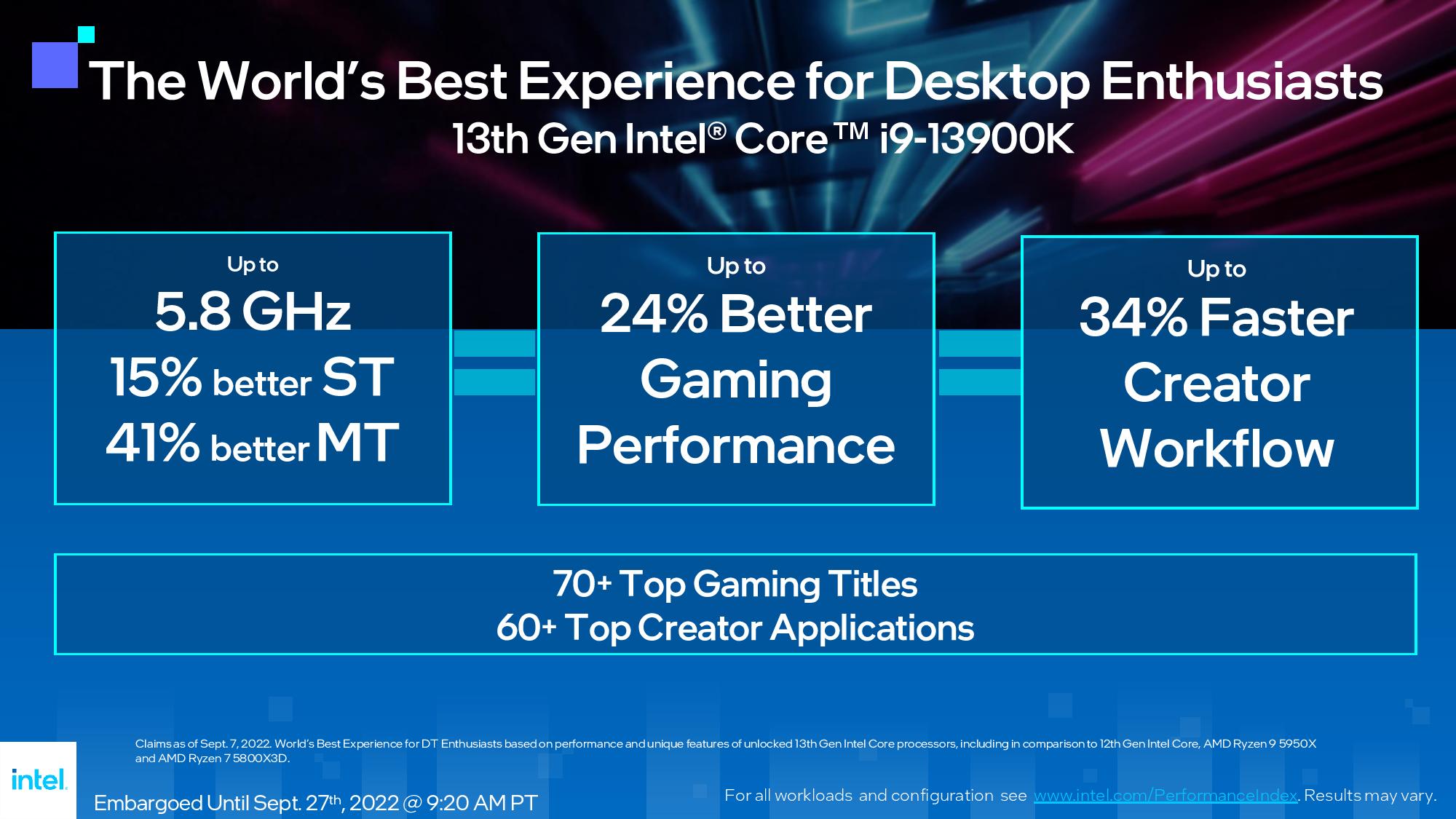
Meanwhile, the $319 Core i3-13600K is the lone chip to receive a price increase; both the full-fledged model and the graphics-less 13600KF are $30 more expensive than the prior gen. This is by far the highest-volume SKU and slots into a pricing tier where AMD isn't as competitive, so Intel's increase here will generate the most cash while not threatening its strategy of undercutting AMD on the high end. However, AMD's $299 Ryzen 5 7600X is a potent gaming chip, so we'll have to see how the performance story plays out when Raptor Lake hits our bench table.
The 13600K receives four more e-cores than the prior-gen, 200 MHz higher p-core clocks to reach 5.1 GHz, and a 300 MHz e-core improvement yields a 3.9 GHz boost.
The 13600K also has a 31W MTP increase to 181W, so Intel is raising power limits here, too.
Some of the improvements apply to all three chips. For example, Intel increased the L2 cache from 1.25MB to 2MB for each p-core, and doubled the amount of L2 cache for each cluster of e-cores to 4MB. The amount of L3 cache has also increased due to adding more e-core clusters, each of which has an adjacent L3 cache slice as part of the design. That leads to cache capacity increases for all K-series Raptor Lake chips.
Intel has increased its DDR5 memory support up to 5600 MT/s if you use one DIMM per channel (1DPC), a big increase over the prior 4800 MT/s speed with Alder Lake. Just as importantly, Intel increased 2DPC speeds up to 4400 MT/s, an improvement over the previous-gen 3600 MT/s. Intel will also continue to support DDR4 memory, which it predicts will coexist in the market with DDR5 until the end of 2024. This approach ensures a value option for Intel platforms, unlike AMD's all-in approach with DDR5.
Raptor Lake and Alder Lake will be compatible with new 700-series and existing 600-series motherboards. As usual, Intel will bring its Z-series (Z790, in this case) motherboards to market first, with the value-centric B- and H-series coming when it launches the rest of the Raptor Lake lineup.
The 700-series motherboards bring minor improvements over the 600-series, but Intel has increased the number of PCIe 4.0 lanes hanging off the chipset to 20, an increase of eight additional lanes. Intel also added support for one more USB 3.2 Gen 2x2 200Gps port, bringing the total to five. As before, the Raptor Lake chip itself supports 16 lanes of PCIe 5.0 and four lanes of PCIe 4.0 for a storage device.
Intel Raptor Lake Gaming Benchmarks

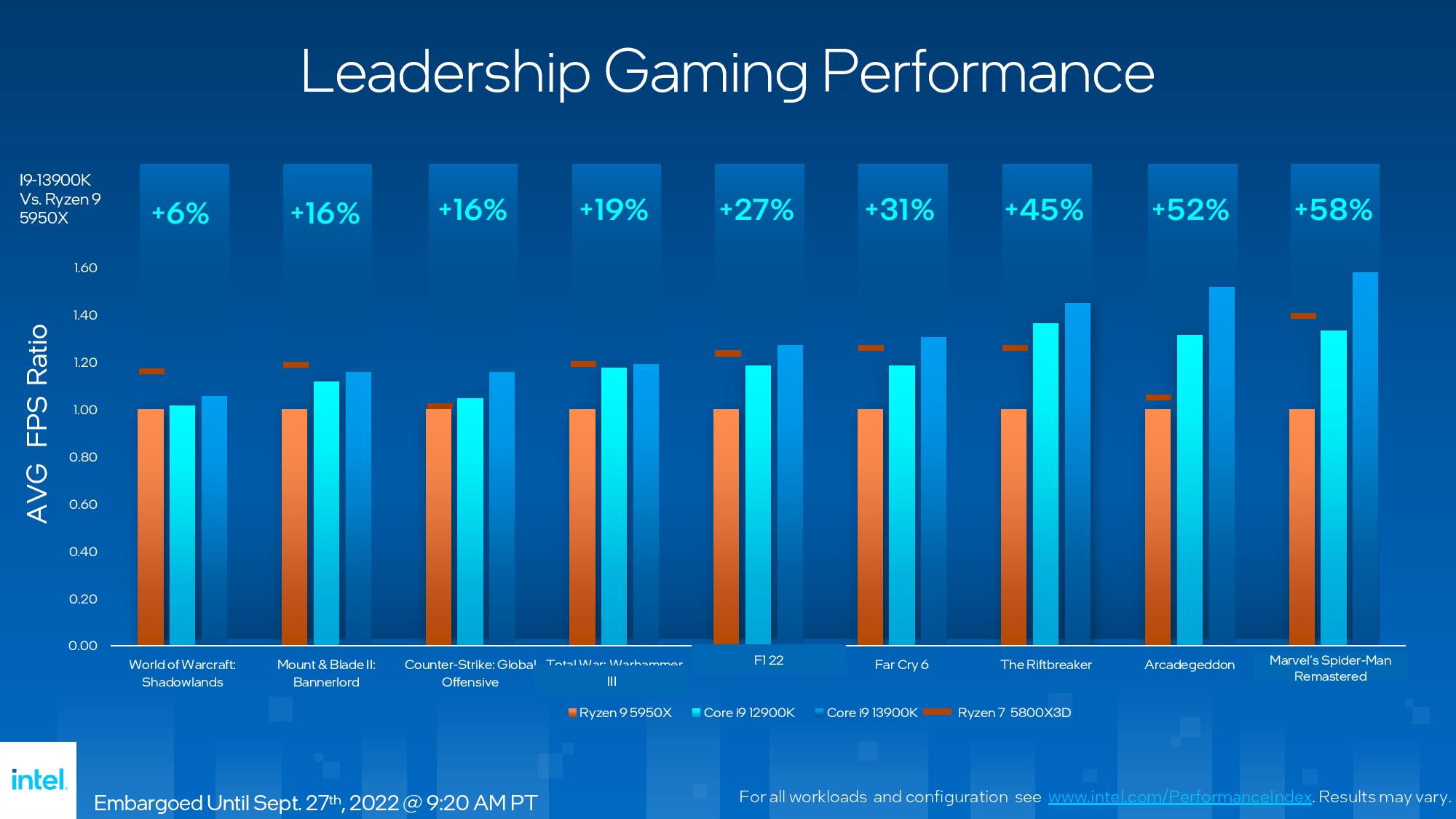



Intel shared its own performance benchmarks, but as with all vendor-provided benchmarks, take them with some salt and wait for reviews. We've included the test notes at the end of the article.
Intel claims that the Core i9-13900K is 5% faster than the 12900K in more than half of the 32 games it tested, and up to 25% faster in some. In our testing, AMD's recently released Ryzen 9 7950X is roughly 5% faster in gaming than Intel's Core i9-12900K. Given that Intel claims most titles will land at 5% faster than the 12900K or above, we will surely see a very close race between the chipmakers.
Intel also shared projections against AMD's now previous-gen Ryzen 5000 chips, but the company didn't have access to the new Ryzen 7000 for testing. The percentages at the top of the second slide are versus AMD's Ryzen 9 5950X, but you'll notice that the Ryzen 7 5800X3D is only represented as a thin line above the 5950X bar on the chart. The exotic and pricey 5800X3D is currently the fastest gaming chip on the market, courtesy of its 3D V-Cache tech. Still, you do have to remember that the 5800X3D doesn't accelerate all games and comes with severe tradeoffs in application performance compared to similarly-priced chips.
It appears that Raptor Lake will beat the 5800X3D in some titles, but it won't be able to unseat the 5800X3D from the title of being the fastest for gaming overall. That's not totally unexpected -- even AMD's new Ryzen 7000 can't beat its previous-gen chip.
Intel is also now adding 99th percentile framerates to its marketing repertoire in the 'leadership gaming frame consistency' slide, a first. As a reminder, 99th percentile framerates are popular in CPU and GPU reviews, like ours, because they are a good indicator of the smoothness of a game. So naturally, Intel claims a lead here over the Ryzen 9 5950X. You'll notice the company didn't include the 5800X3D in this slide.
Intel also included a few content creation benchmarks, showing big speedups relative to its previous-gen chips and the Ryzen 9 5950X. The new Ryzen 9 7950X is incredibly powerful in content creation apps, but it looks like we'll see another tight race when the 13900K arrives.
Intel 13th-Gen Raptor Lake Architecture
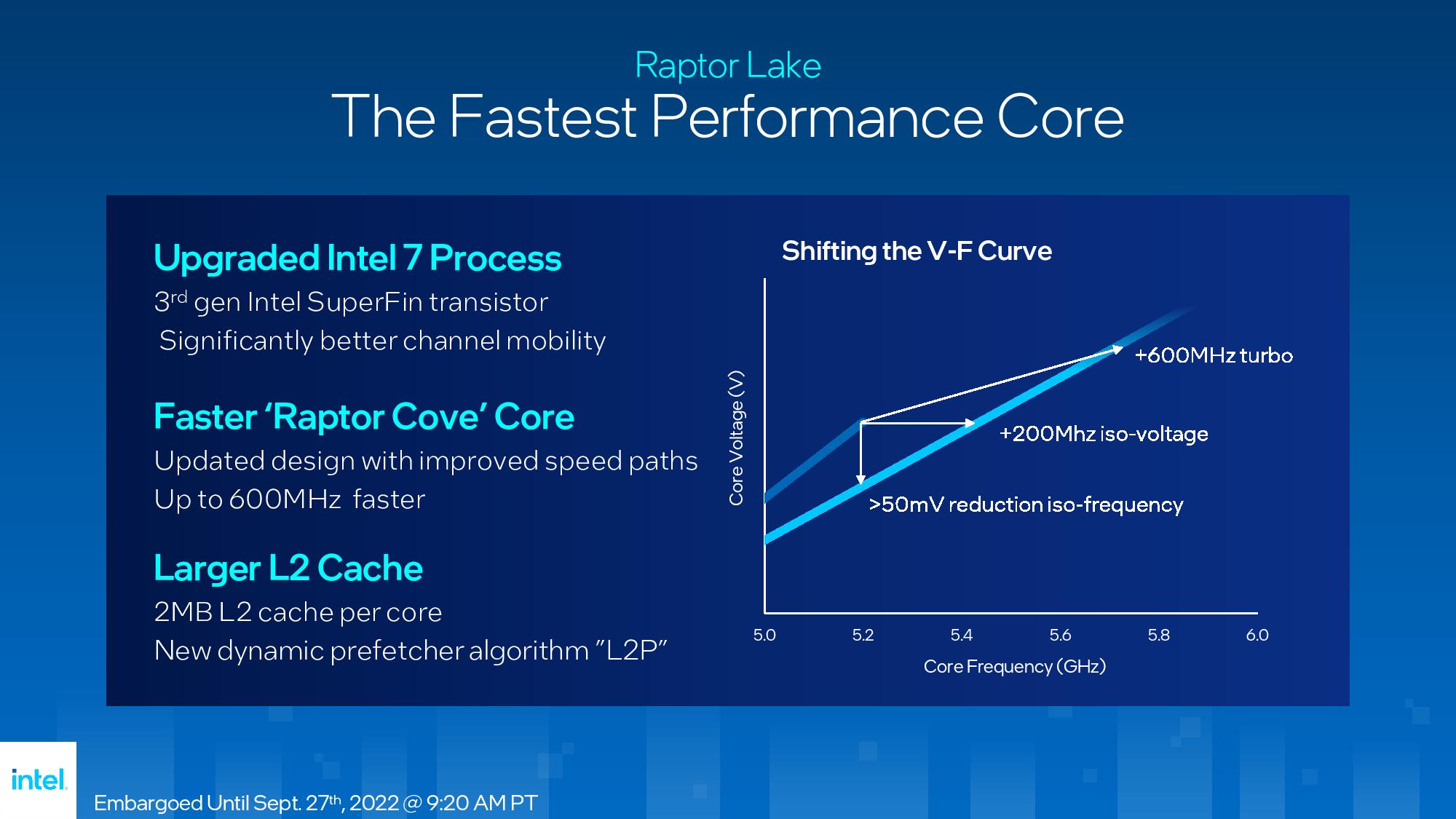

Intel significantly improved its 'Intel 7' process node by employing faster third-gen SuperFin transistors and increasing the channel mobility (Intel declined to provide more specifics on the latter). Intel claims this yielded what would typically be considered a full node's worth of performance improvement. As you can see above, this allowed Intel to 'shift and extend' the voltage/frequency curve to deliver better performance at both high and low voltages (>50mV reduction at the same frequency, or a 200 MHz increase at the same voltage).
We'll soon see a 6 GHz Raptor Lake model because the improved node characteristics paired with improved speed paths within the design (likely using leakier, faster transistors in key paths) allowed Intel to dial up the peak clock rates by 600 MHz. Intel says that Raptor Cove is the fastest core it's ever built, but that the Raptor Lake mobile chips will be tuned more for the lower-power end of the V/F curve to improve efficiency.
Intel's larger 4MB L2 cache on the e-core clusters also employs a new dynamic prefetching algorithm that uses real-time telemetry data and machine learning to dynamically adjust the prefetch algorithm based on the type of workload it is executing. Intel says this helps improve performance in some types of applications by ~2%, like Adobe Photoshop, After Effects, and Lightroom, and in an unspecified application by up to 16%.
Intel also employs a different dynamic 'Inclusive/non-inclusive' (INI) approach for its L3 cache, but this adjusts between inclusive and non-inclusive caching schemes on the fly. Caches are typically hard-coded to run with either of these policies and can't be changed.
As a reminder, inclusive caching keeps a copy of L2 data in the L3 cache and typically improves performance in single-threaded work by providing a faster hit rate for serial workloads, while non-inclusive caching only keeps part of the L2 cache in L3 to improve performance in threaded workloads. Intel's INI uses machine learning and real-time telemetry to make changes to this policy on the fly, thus providing the best of both worlds.
We spoke with Intel Fellow and Chief CPU Architect, Adi Yoaz, at Intel's Israel event about the new scheme, and he tells us that this approach is the result of the microcontroller that Intel originally designed into each Alder Lake core, but hasn't yet fully used. New firmware updates to this microcontroller employ machine learning algorithms that better analyze telemetry data to make adjustments to the caching scheme at a 200-microsecond granularity. We'll share more details about this tech in our review.
Speaking of telemetry, Intel's Thread Director, which steers threads to the right type of core (p- or e-core) based on the type of workload, gets a significant overhaul in the Windows 11 22H2 update. Intel has updated the workload classification engine with machine learning algorithms and also improved the handling of foreground and background tasks.
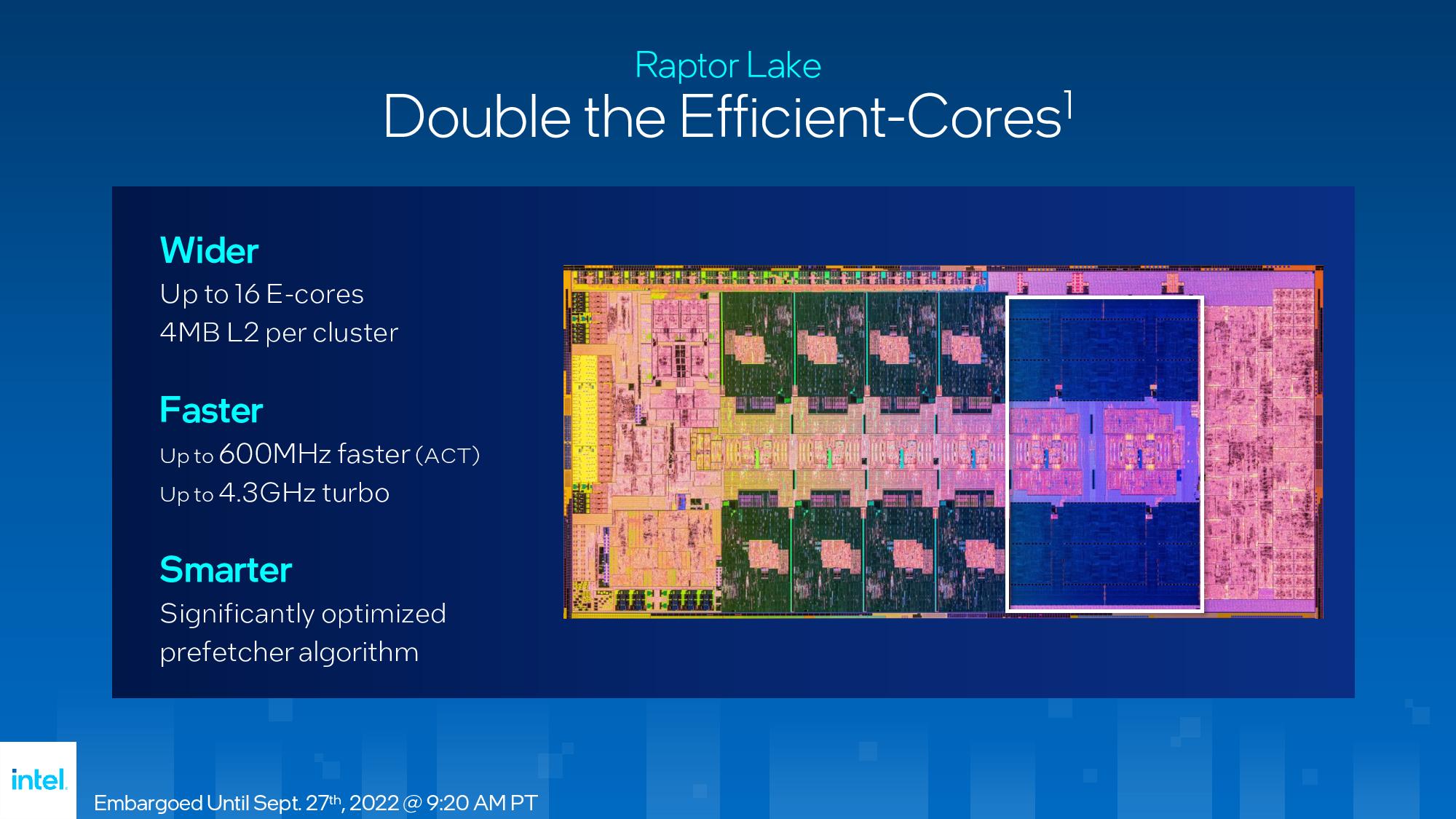
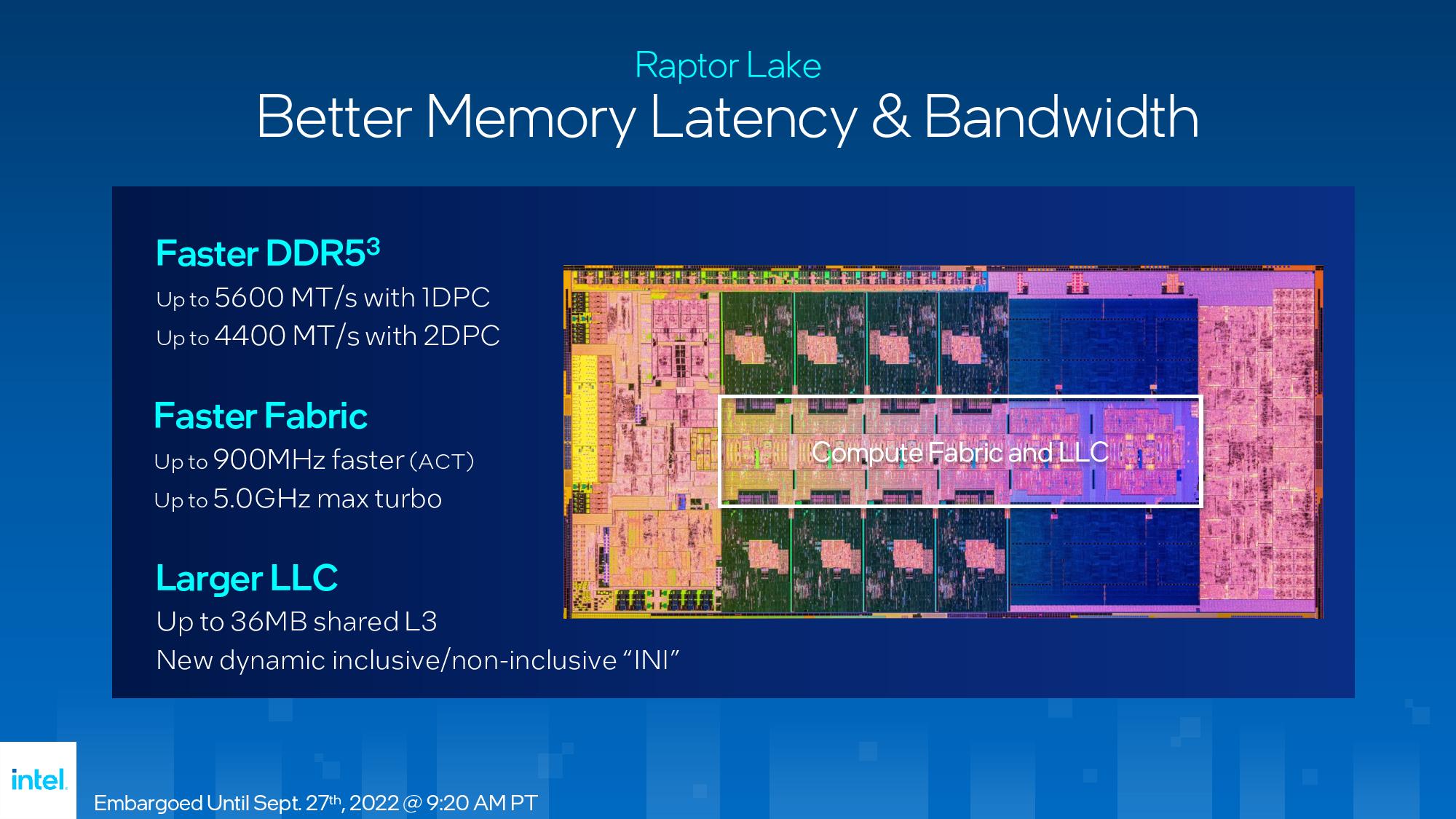
Above, you can see an image of the Raptor Lake die, with the e-cores highlighted in blue. Intel has created one new Raptor Lake die that it will use for all three K-series models. This same die will also serve all other Core i9 and i7 models, but only some Core i5s. Intel has added two additional quad-core e-core clusters to the die, which essentially elongates the die. As you can see from the unofficial die measurements we have in the table below, the die is also slightly wider.
Intel has confirmed that e-cores are coming to the entire Raptor Lake Core i5 lineup. Currently, only the Core i5 'K' Alder Lake model has four e-cores, while the others do not.
Intel has improved the frequency of the e-cores up to 4.3 GHz on the 13900K, and it has also increased the all-core clock rates by 600 MHz.
Leveraging the faster memory speeds requires a faster fabric. Intel has increased the ring bus frequency to 5 GHz and it is 900 MHz faster during all-core turbo, addressing a glaring issue we saw with Alder Lake. Intel says the ring bus enhancements alone can result in 5% higher framerates (we've also seen solid increases from overclocking this setting on Alder Lake).
| Row 0 - Cell 0 | Die Area | Die Dimensions | Cores | Process |
| Raptor Lake Core i9-13900K | 257 mm^2 | 23.8 x 10.8 mm | 8 P-Cores | 16 E-Cores | Intel 7 |
| Alder Lake Core i9-12900K | 208 mm^2 | 20.4 x 10.2 mm | 8 P-Cores | 8 E-Cores | Intel 7 |
| Rocket Lake Core i9-11900K | 281 mm^2 | 24 x 11.7 mm | 8 P-Cores | 14nm |
| Comet Lake Core i9-10900K | 206 mm^2 | 9.2 x 22.4 mm | 10 P-Cores | 14nm |

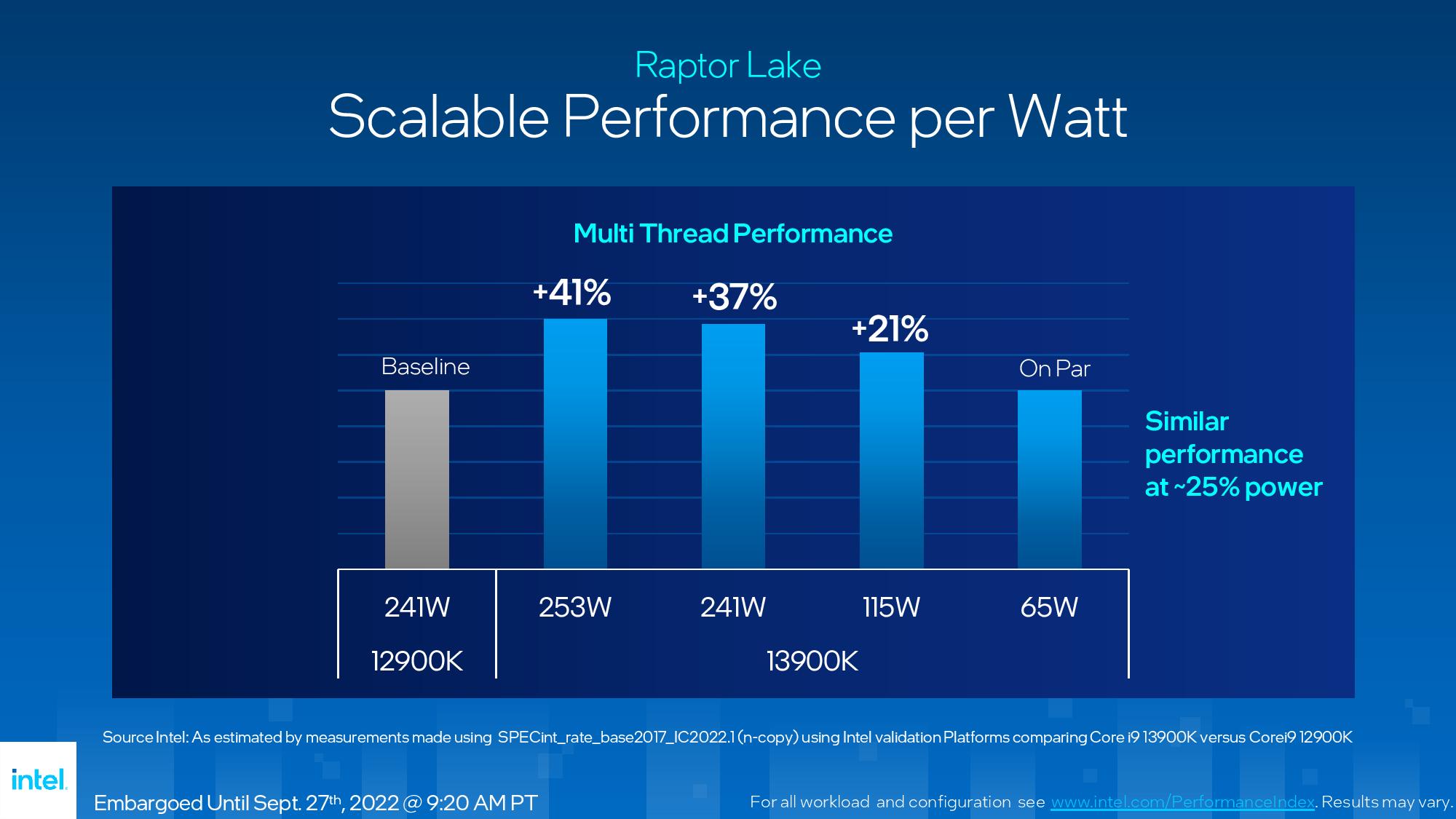
As a result of frequency, memory, cache optimizations, and more threads, Intel claims that Raptor Lake provides 15% more single-threaded performance than Alder Lake and 41% more multi-threaded performance.
Intel also says that Raptor Lake can provide the same performance as Alder Lake in multi-threaded work at a mere quarter of the power. Yes, you read that right -- Intel says Raptor can match a 241W Alder lake chip, but with only 64W of power. We'll put these claimed improvements to the test in our review. If true, that bodes well for Raptor Lake mobile. Speaking of which, Intel says it is working on a new dynamic core parking feature for Raptor mobile chips, but it will share more details later.
Intel 13th-Gen Raptor Lake Overclocking

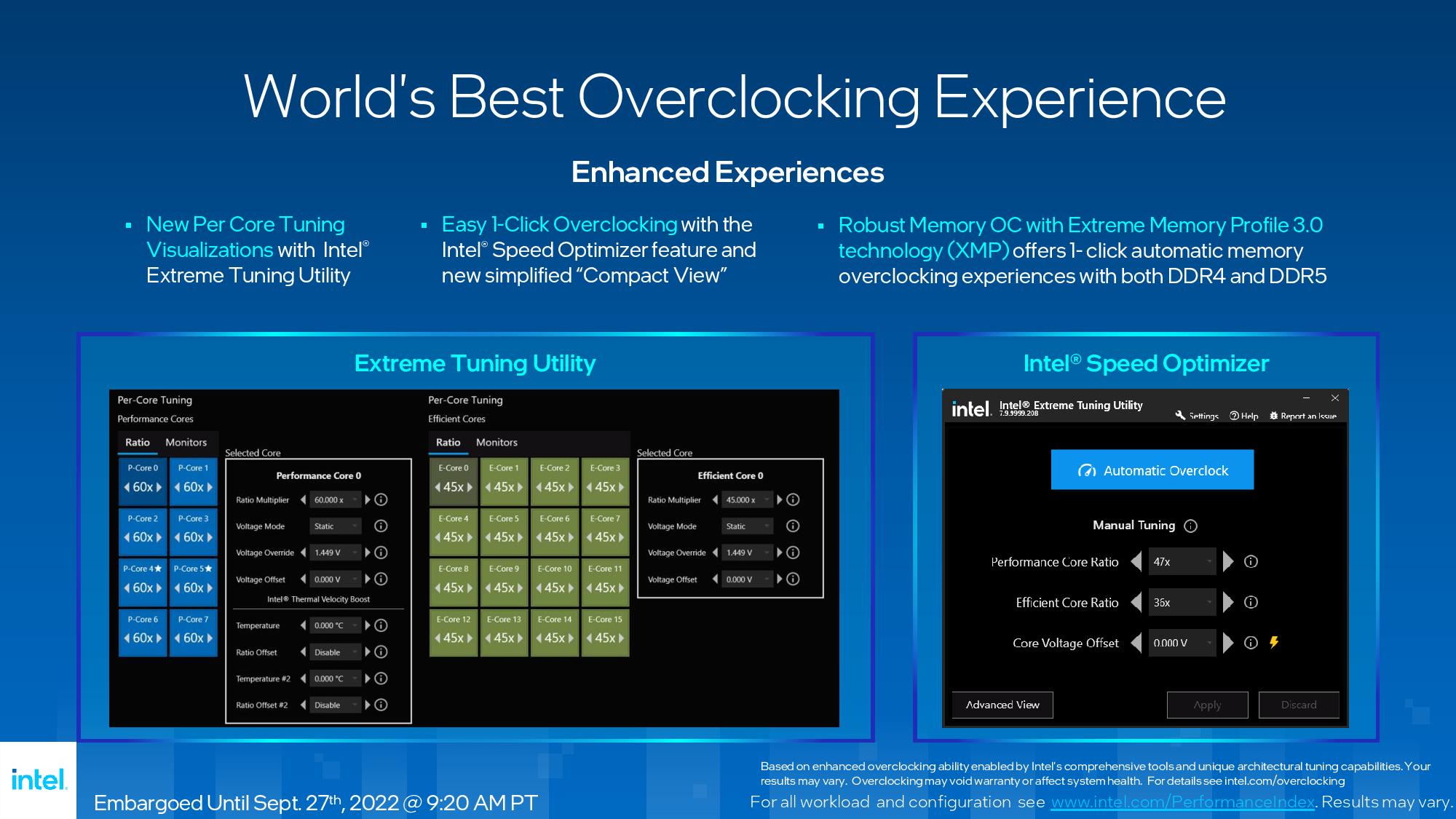
Finally, Intel also shared a few new overclocking features, including a new per-core overclocking feature that is now built into the company's XTU software.
Intel is also reviving its one-click overclocking feature, which previously surfaced as the Intel Performance Maximizer, but is now infusing it directly into the XTU software. Intel never released a one-click overclocking utility for Alder Lake, probably due to the complexities of automatically overclocking both the p-cores and e-cores, but the company has apparently solved those challenges. The 'new' one-click overclocking feature will automatically tune both types of cores.
Intel says we can expect for DDR5-6600 modules with XMP profiles to be available for the Raptor Lake launch. We'll also see XMP DDR5-7200 modules on the market in Q4.
Regardless of the outcome, it's clear that the competition between the Intel Raptor Lake and Ryzen 7000 lineups will be intense when Intel's latest arrives on October 20.
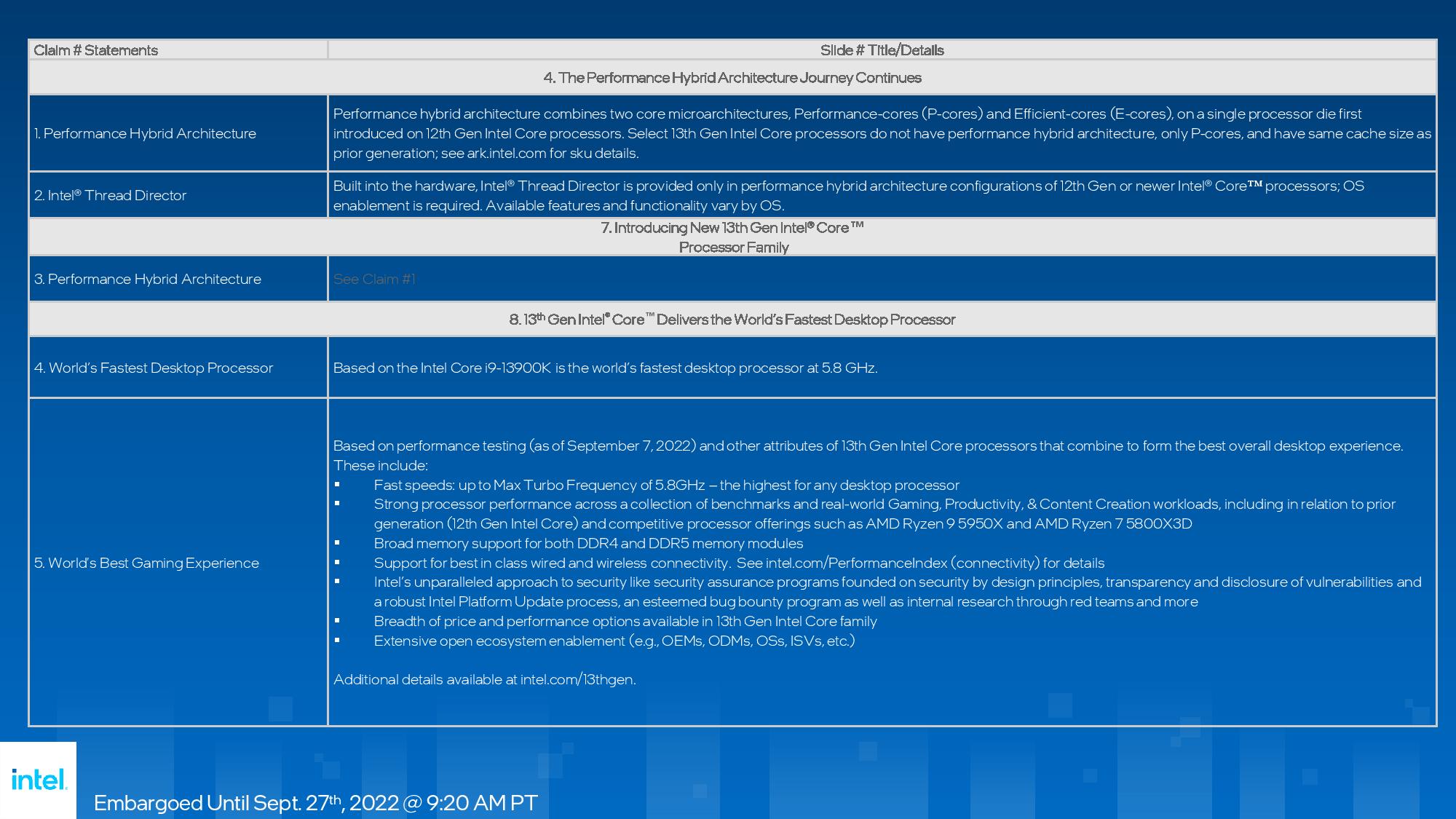

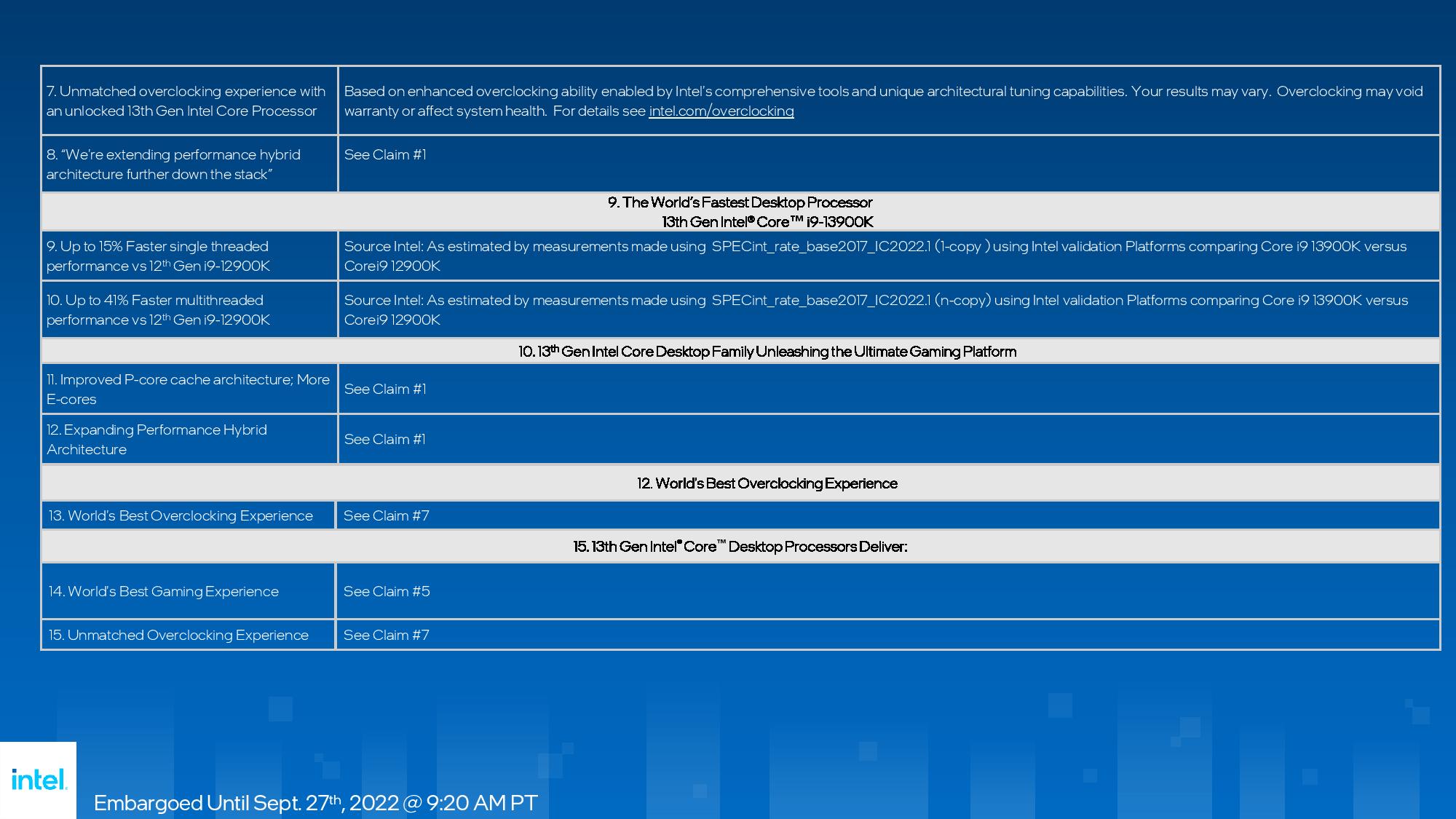
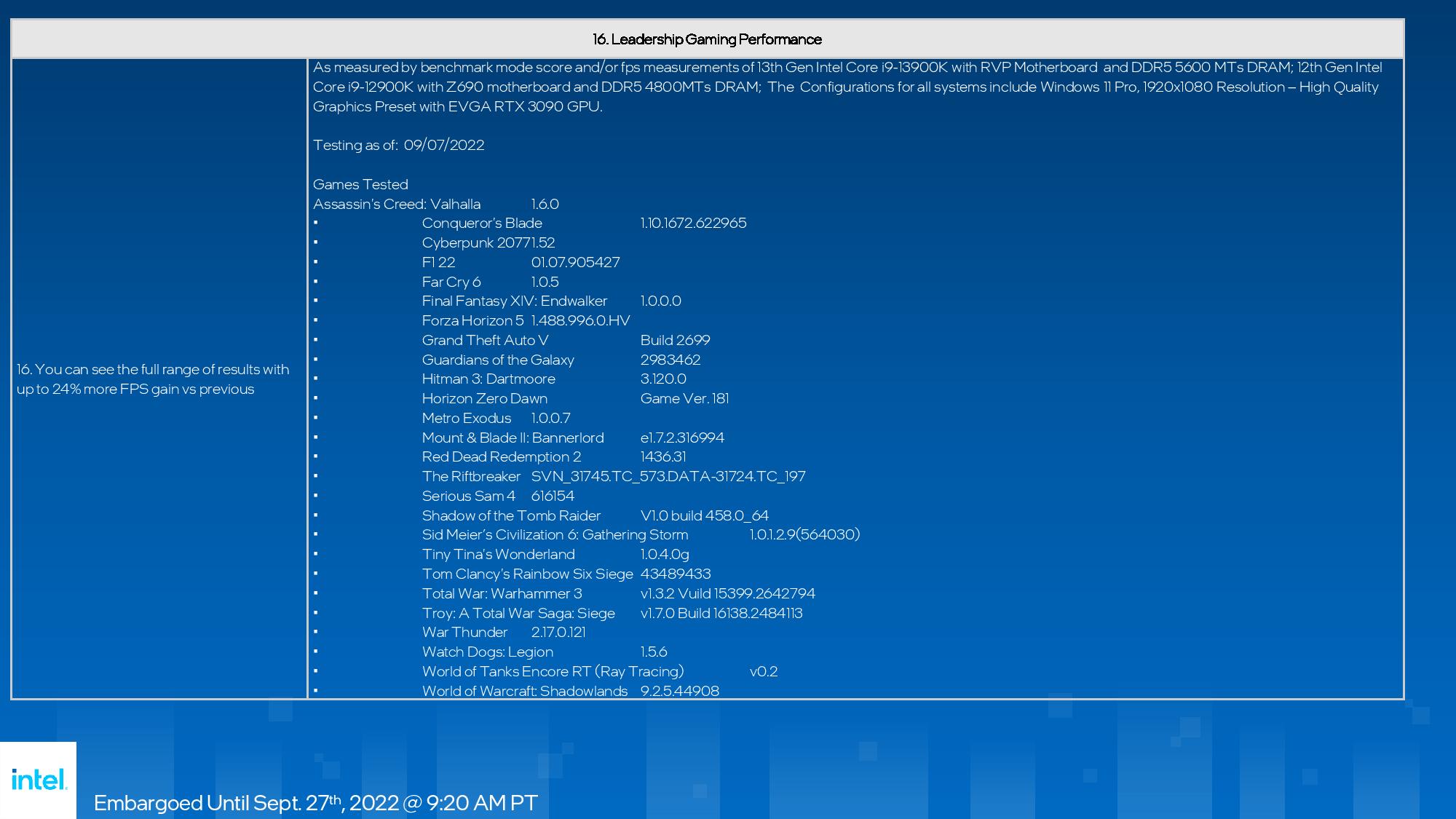
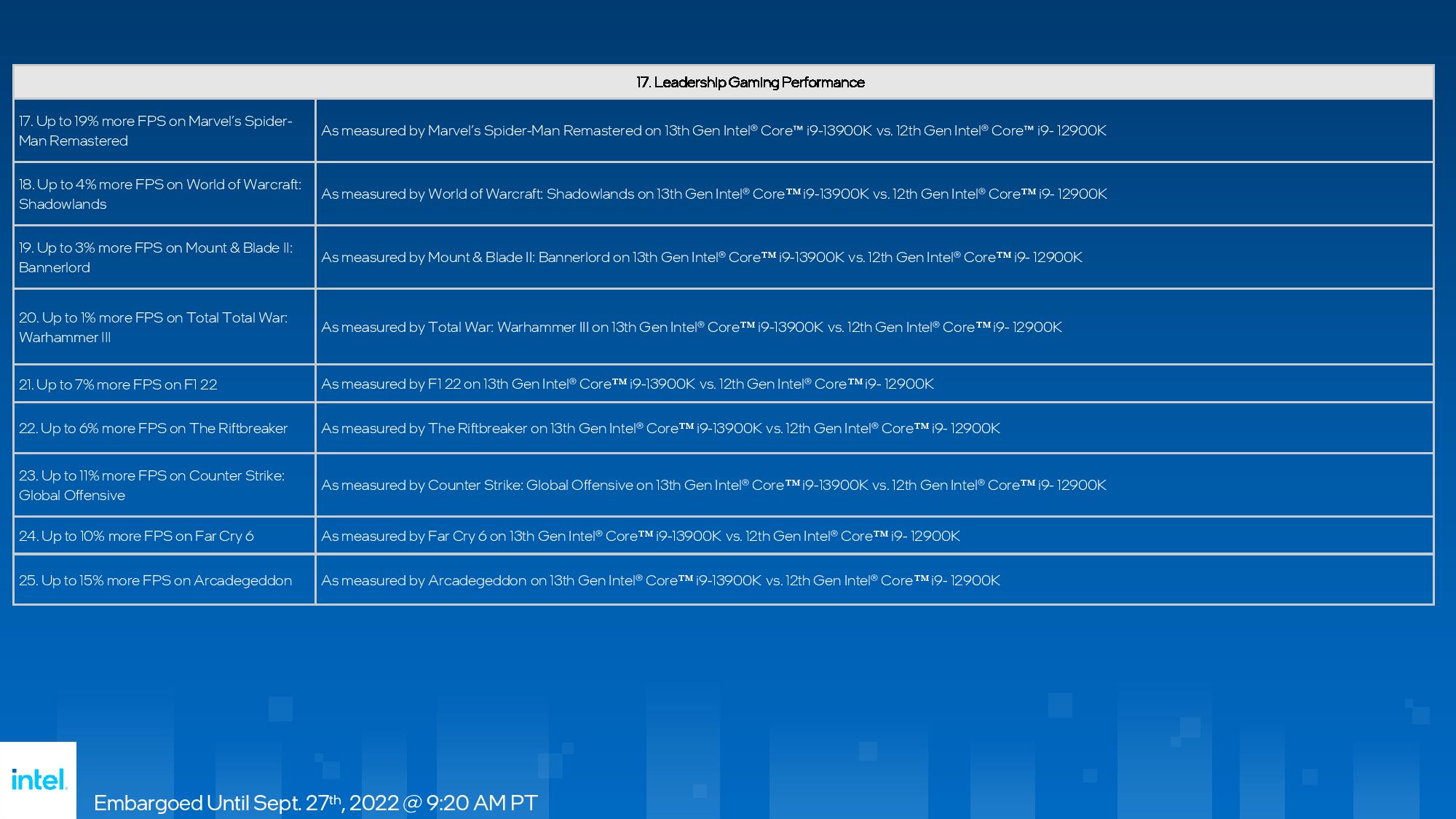
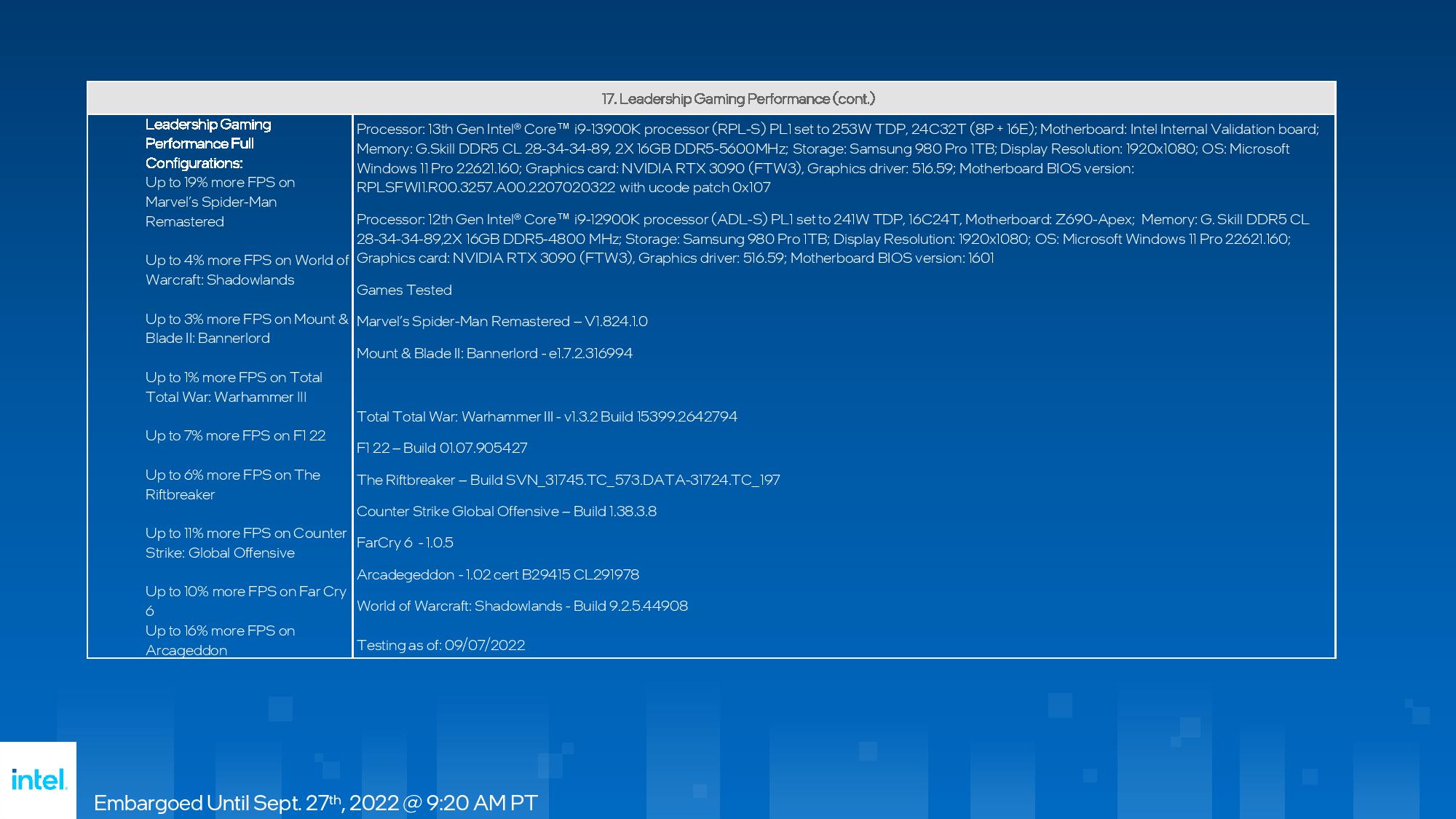

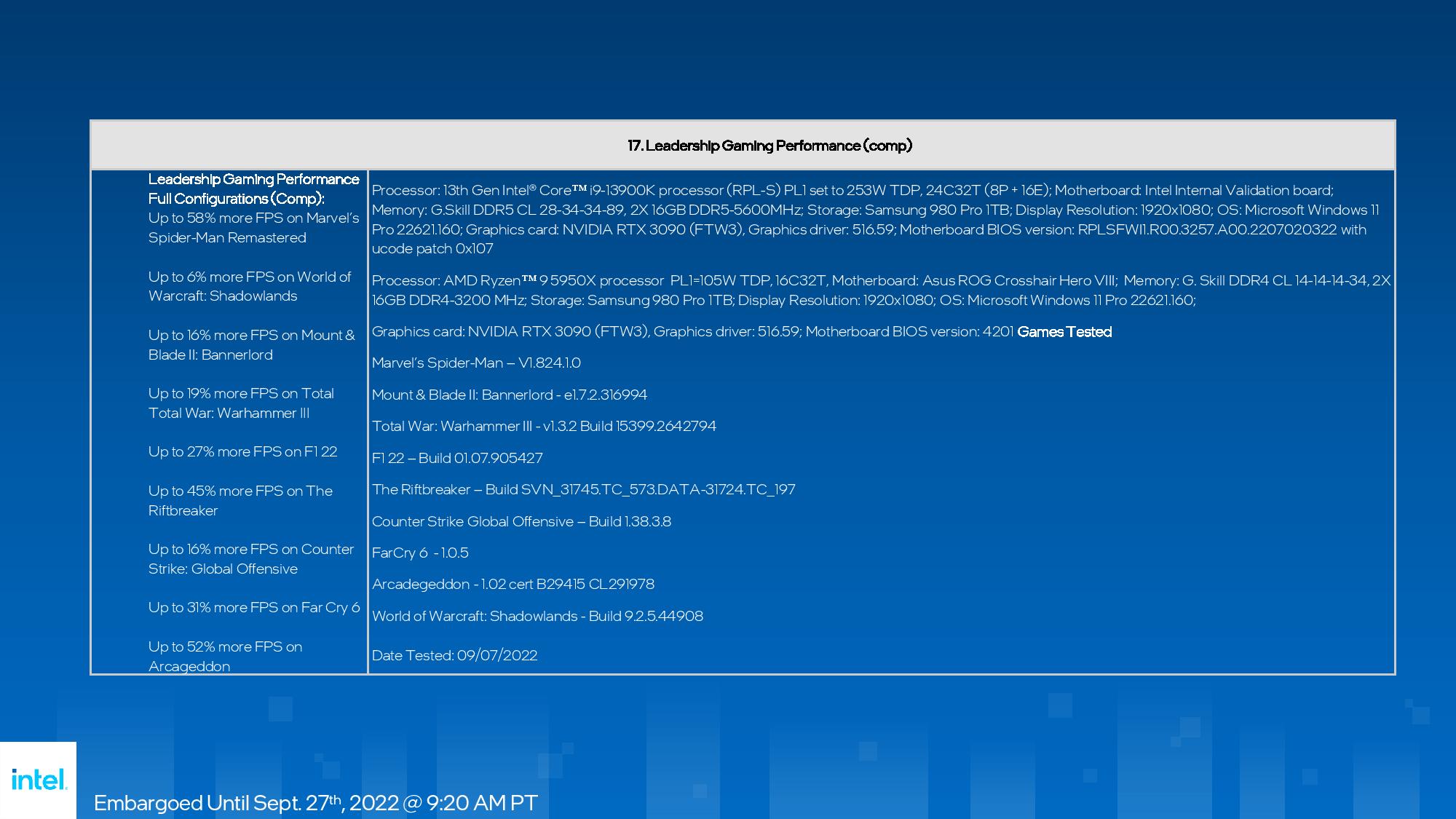
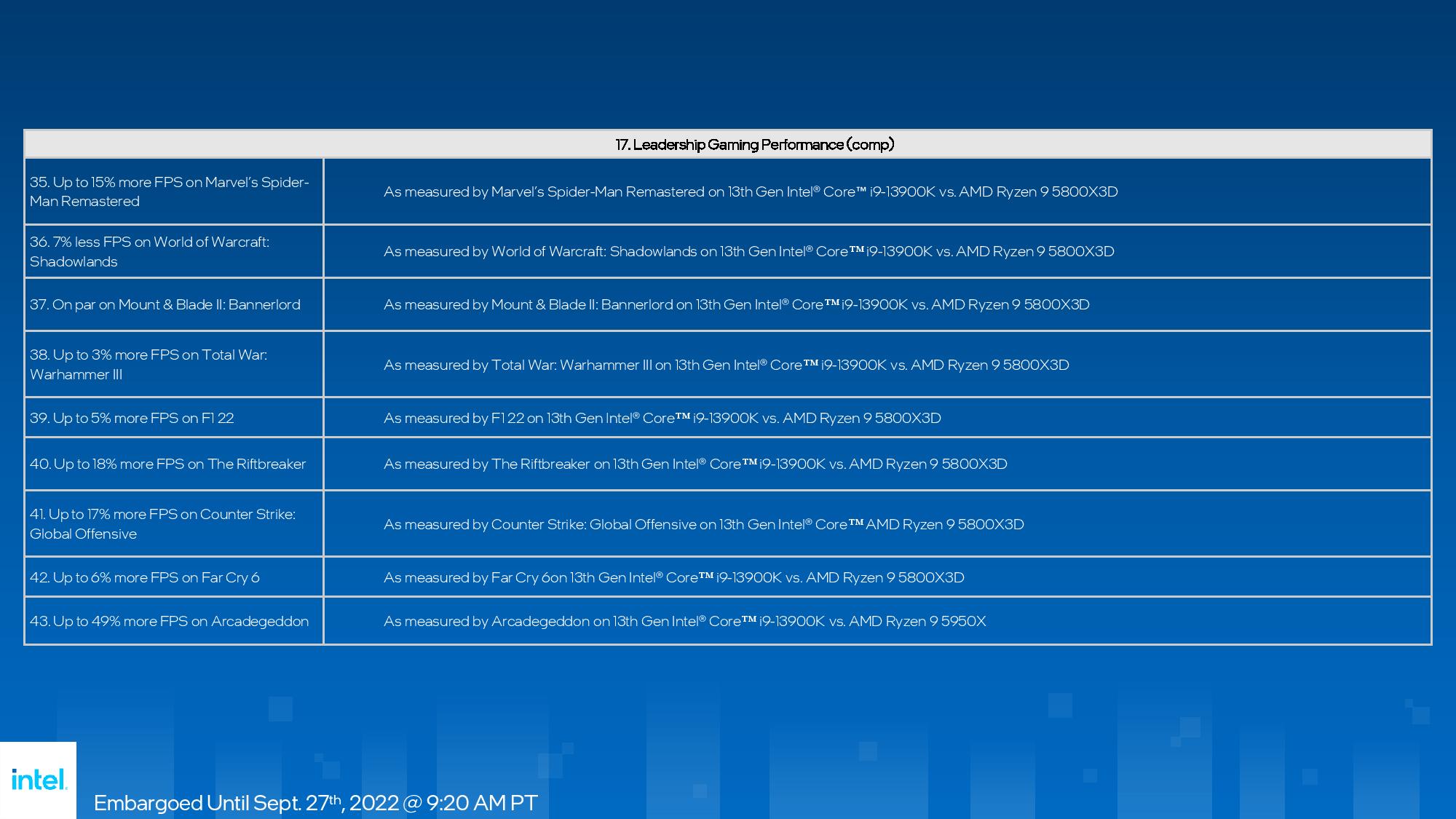
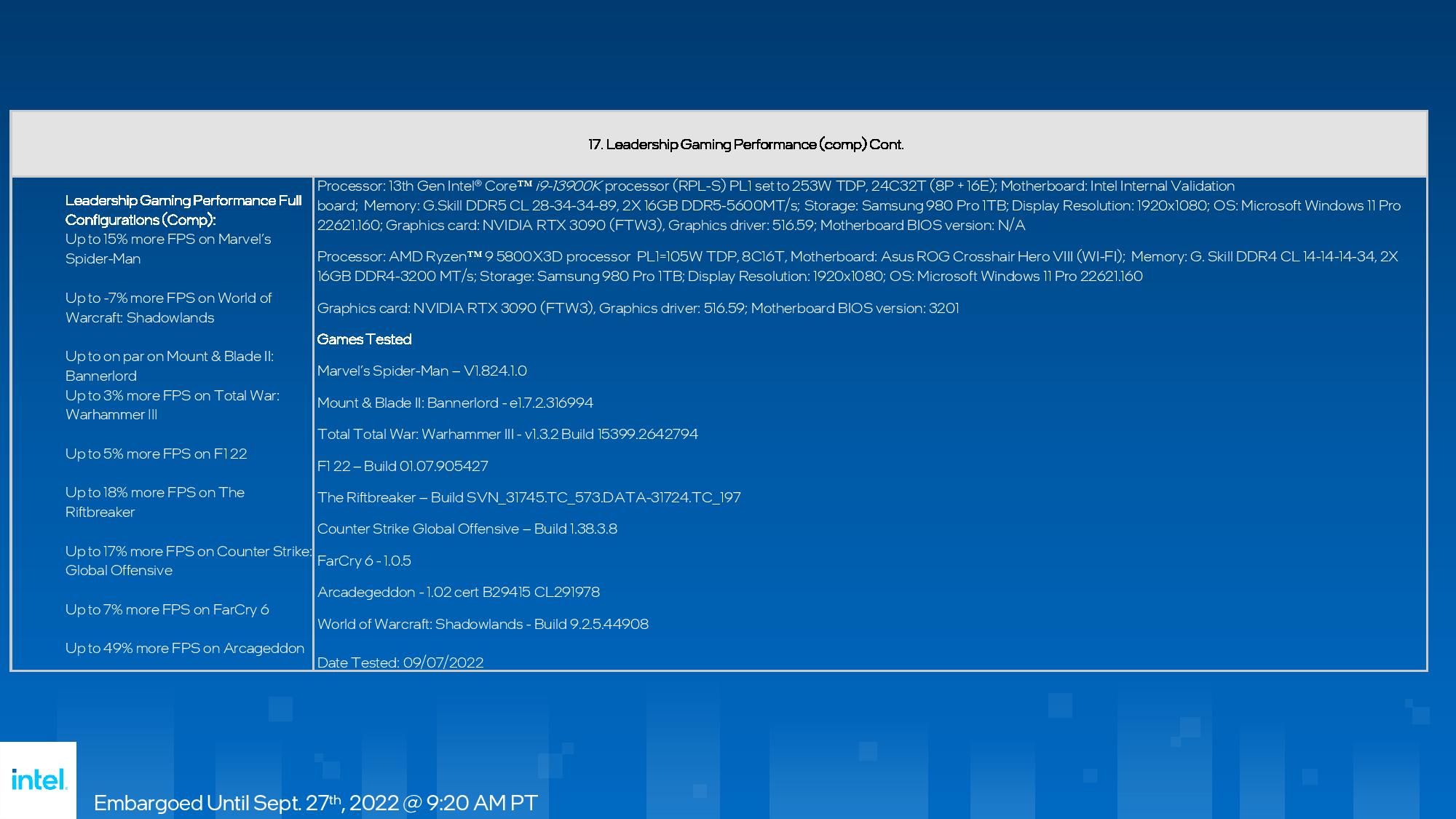
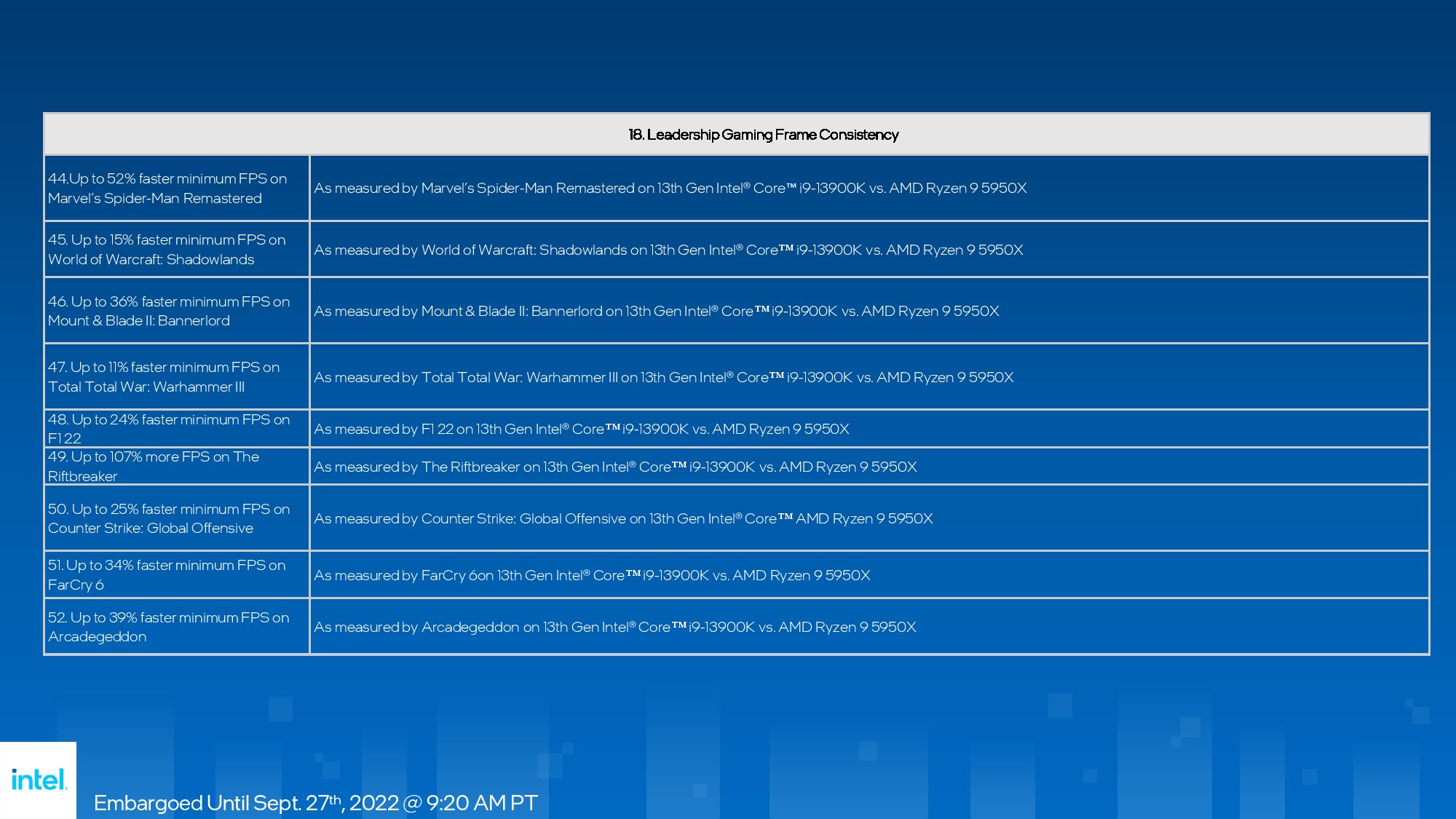
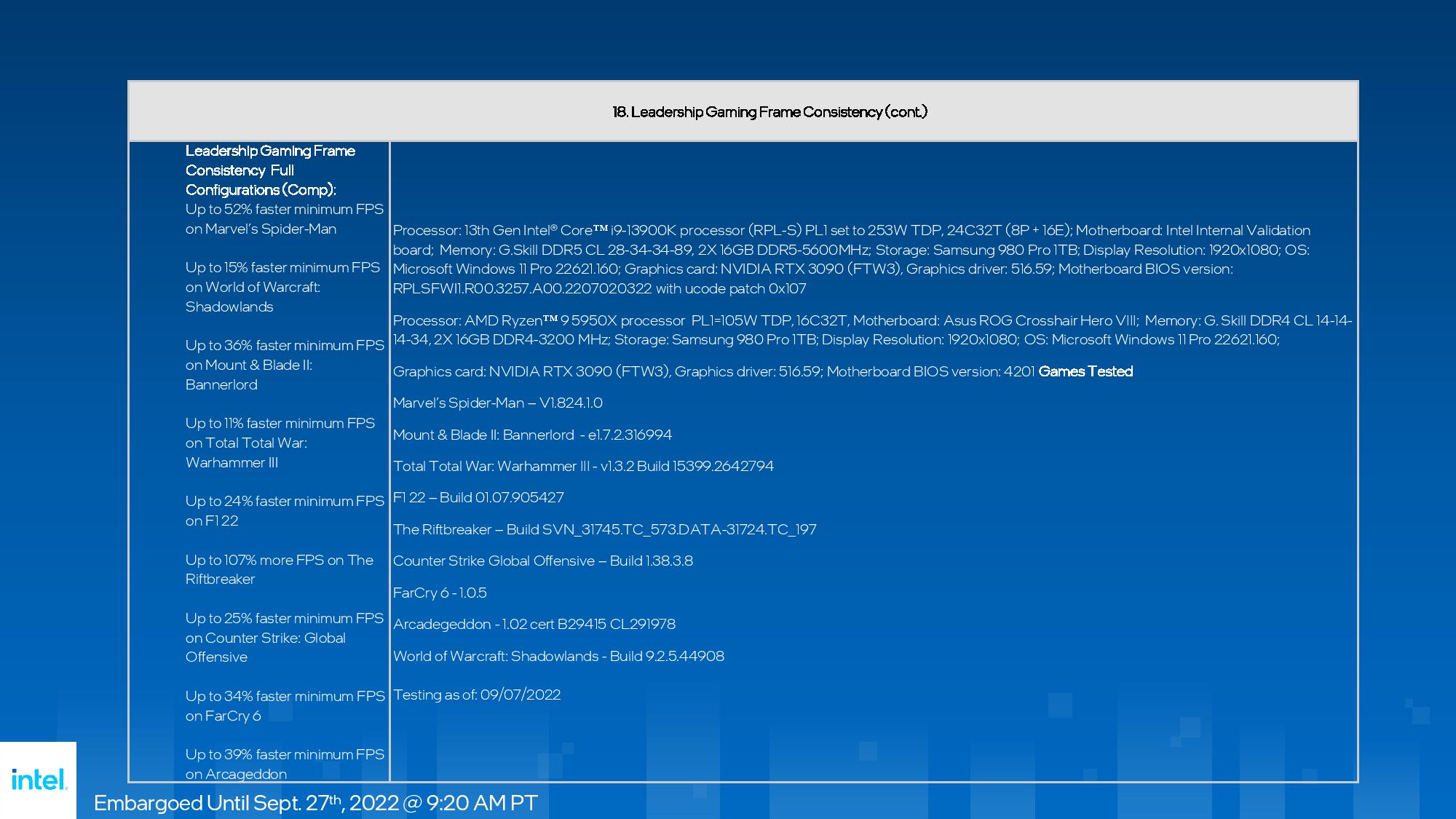

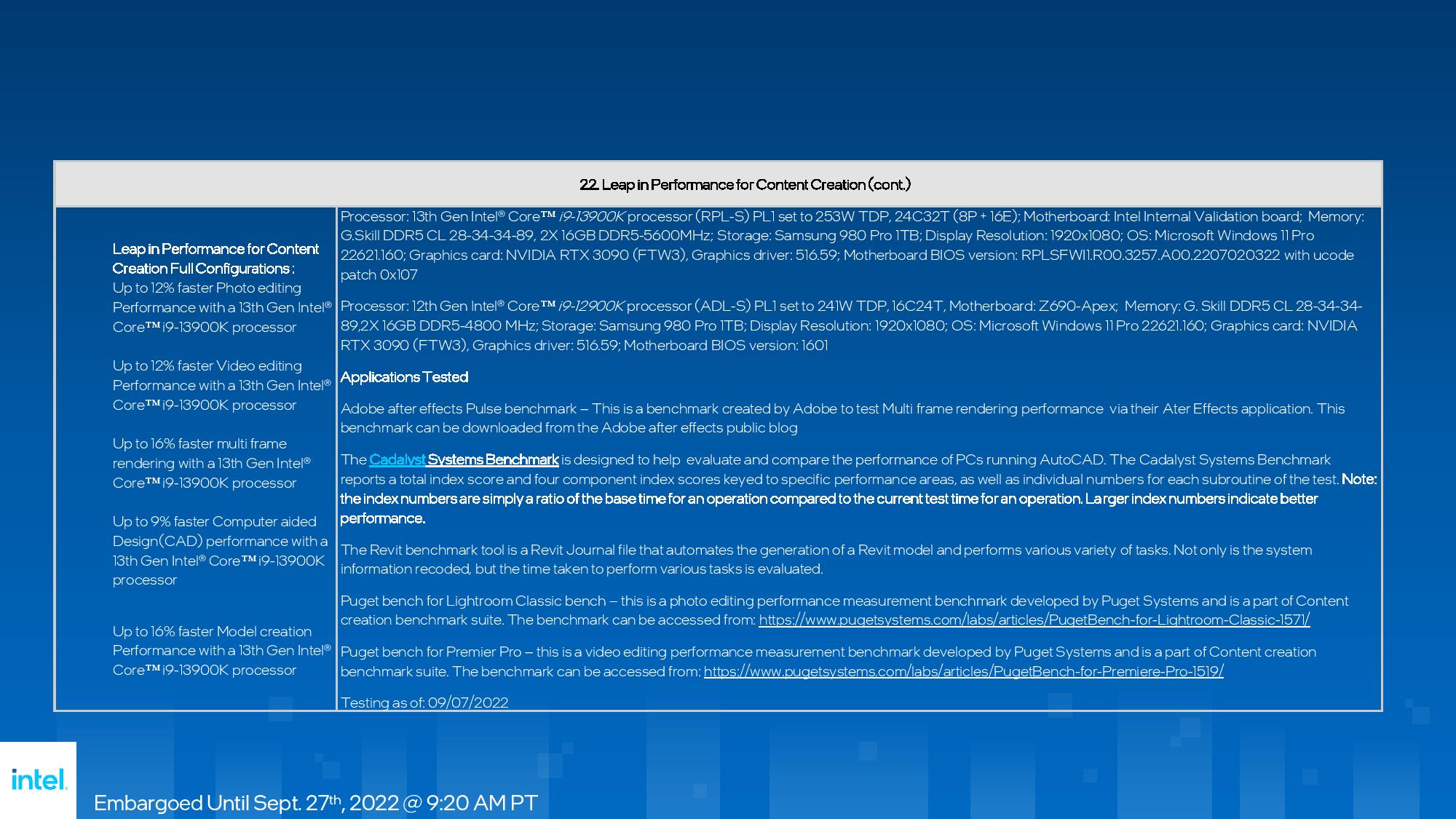

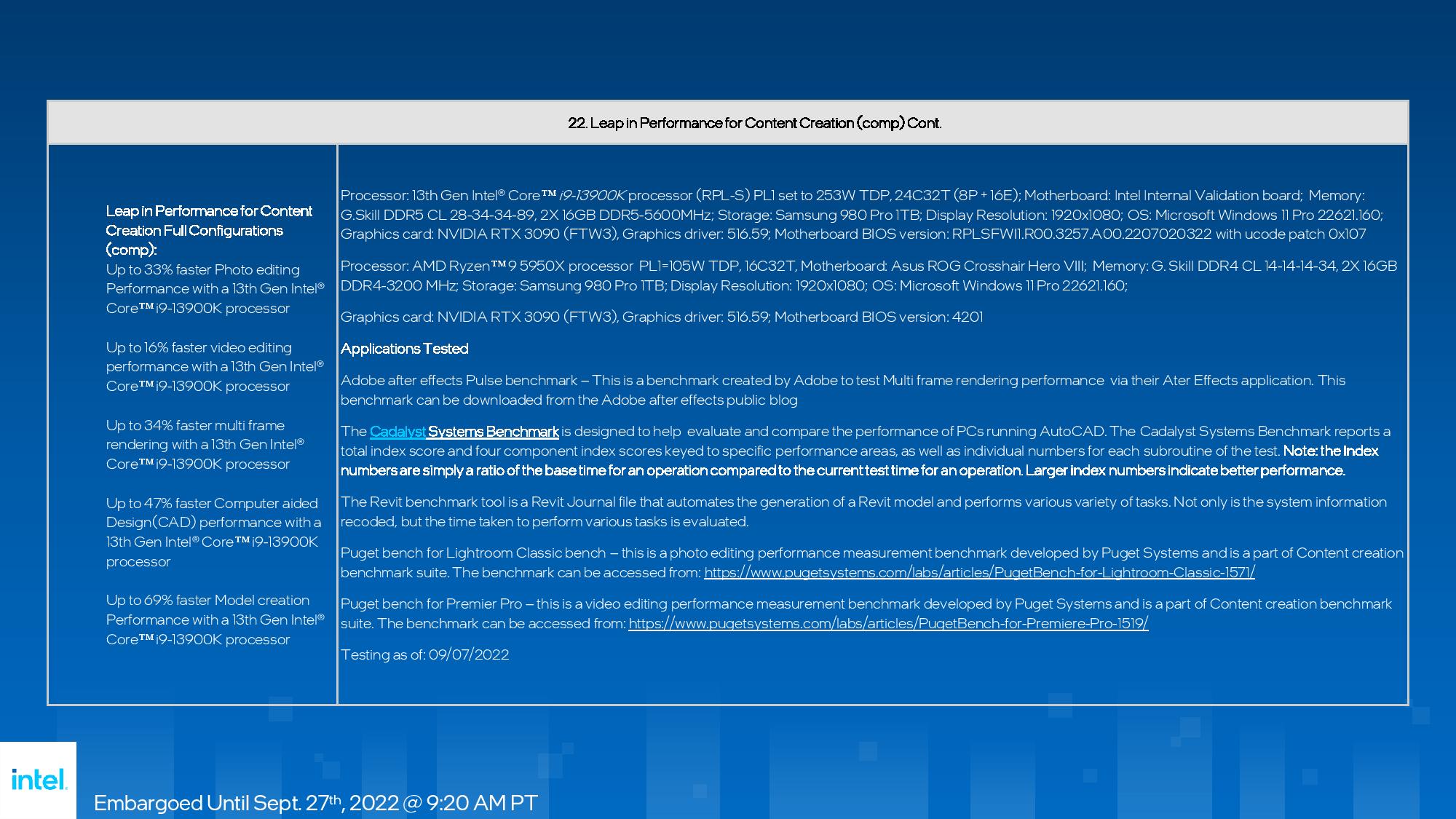
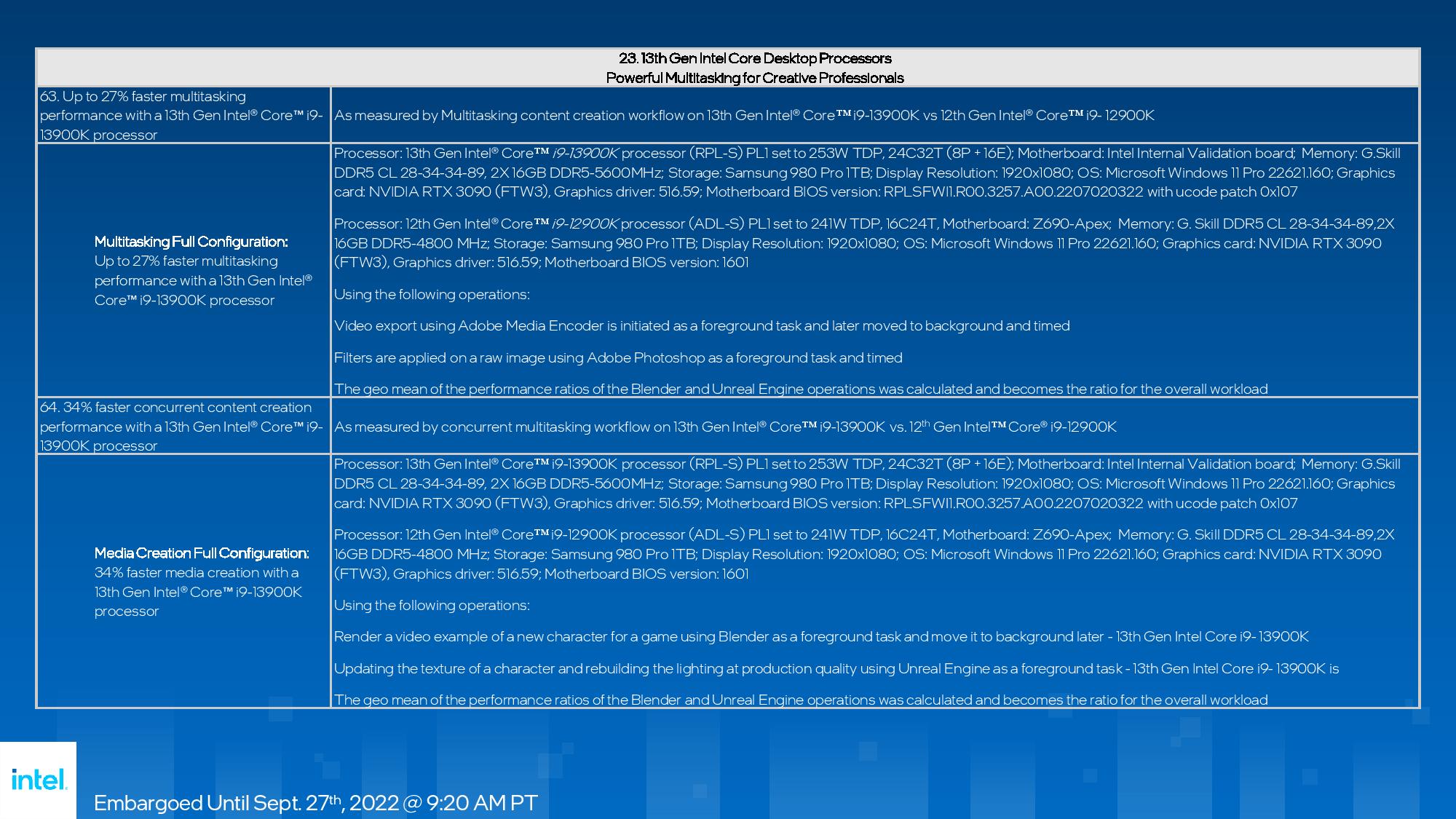
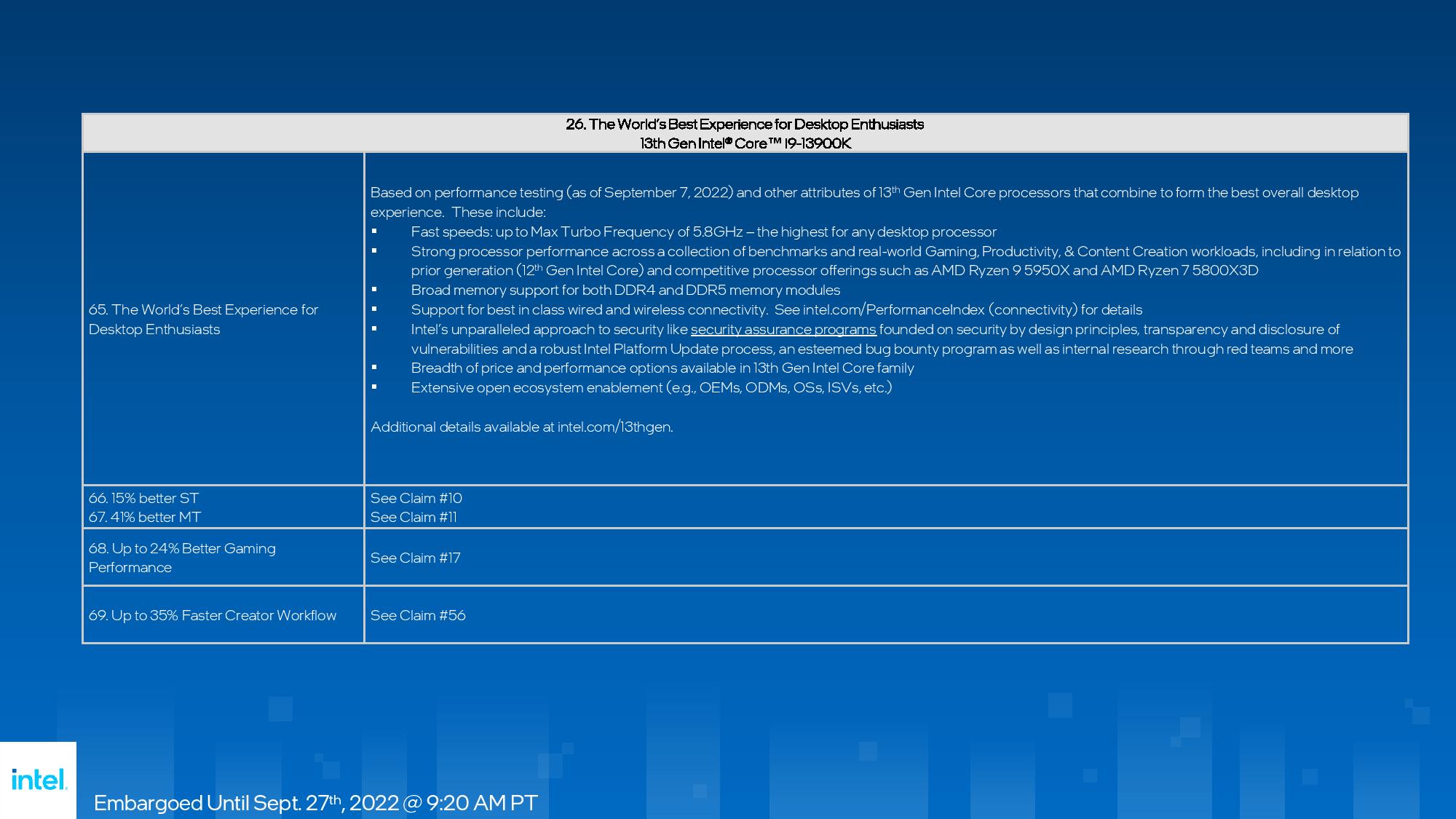
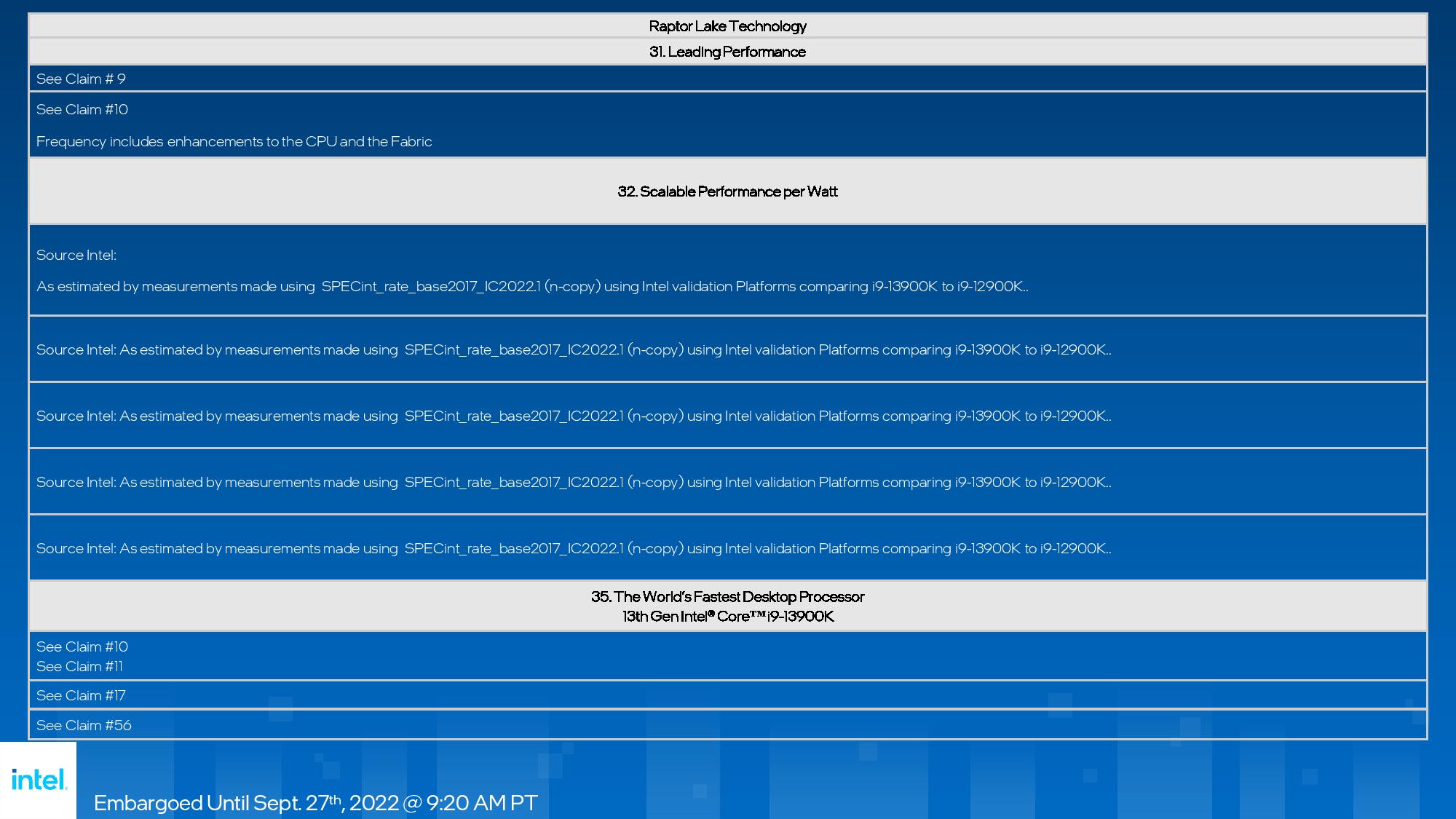
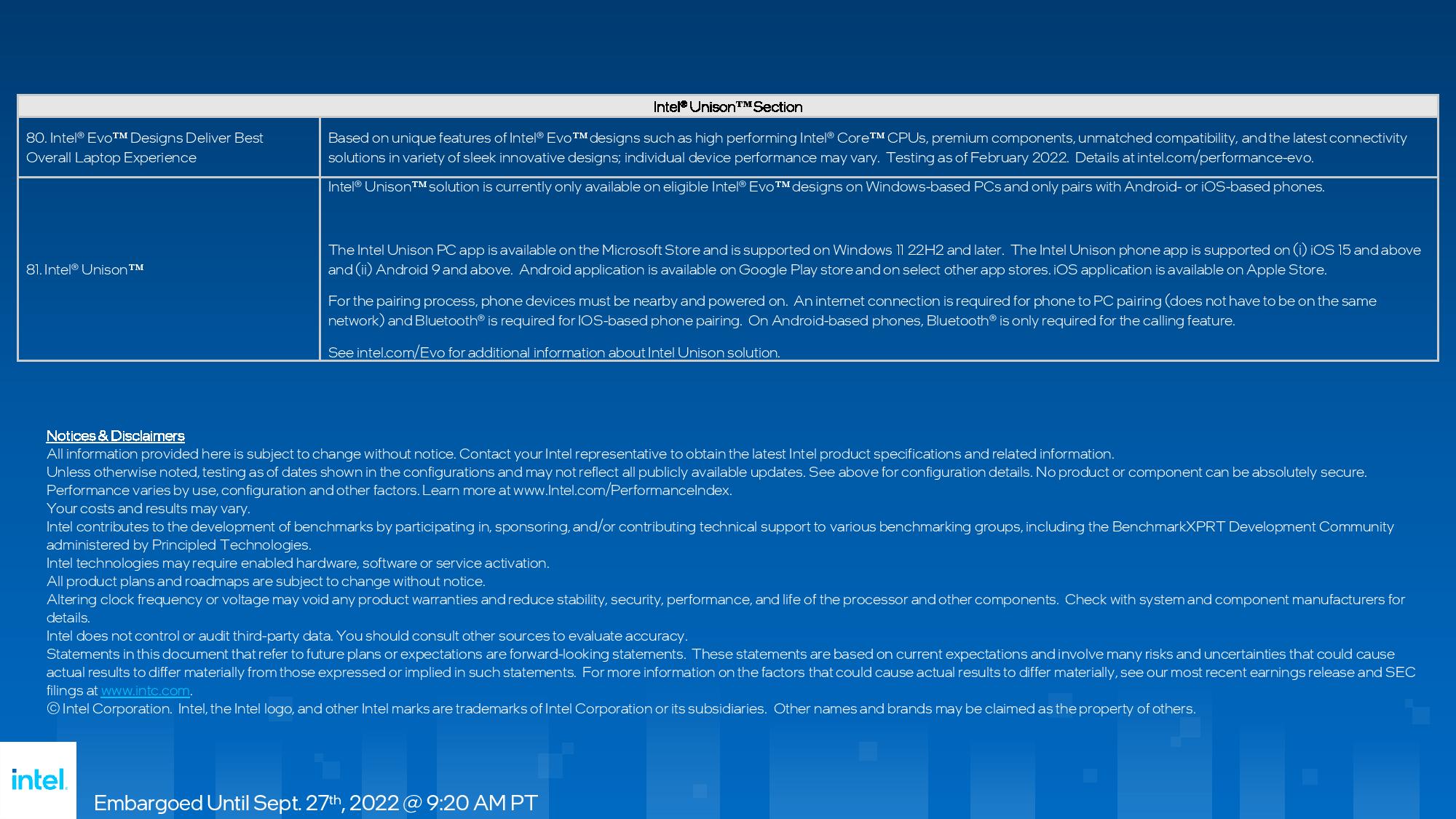



Paul Alcorn is the Editor-in-Chief for Tom's Hardware US. He also writes news and reviews on CPUs, storage, and enterprise hardware.
-
-Fran- This is a strong hint AMD will keep the all-threaded crown in most applications, but will trade blows or lose in gaming.Reply
I think Intel understands the writing on the wall with the 3D chips coming next year and Phoenix on mobile.
The increase in power won't be enough to keep all the little gremlins fed to surpass AMD, I think. And I don't think they'll re-take the efficiency crown... Not that they wanted to, as it had zero mentions. And no; adding more E-cores is not the same as making the whole SoC more efficient XD
Interesting times ahead, for sure.
Regards. -
RichardtST So.... I can get 8 full-throttle cores for $589, or 16 full-throttle cores for $699. Seems an easy choice to me! E-cores are a gimmick. There is no reliable way to determine what any one thread is going to do in the next few milliseconds such that it can be 100% scheduled on the proper core. You need a long consistent history for that, and even given that it is not reliable. By the time you've pegged an E-core a few times and decide to reschedule on a P-core, you've missed a few frames. I ain't falling for it!Reply -
tohiliv895 ReplyRichardtST said:So.... I can get 8 full-throttle cores for $589, or 16 full-throttle cores for $699. Seems an easy choice to me! E-cores are a gimmick. There is no reliable way to determine what any one thread is going to do in the next few milliseconds such that it can be 100% scheduled on the proper core. You need a long consistent history for that, and even given that it is not reliable. By the time you've pegged an E-core a few times and decide to reschedule on a P-core, you've missed a few frames. I ain't falling for it!
its amazing how much nonsense can a one person write... -
TerryLaze Reply
Same...RichardtST said:There is no reliable way to determine what any one thread is going to do in the next few milliseconds such that it can be 100% scheduled on the proper core.
-
TerryLaze Reply
Which part is the hint?!-Fran- said:This is a strong hint AMD will keep the all-threaded crown in most applications, but will trade blows or lose in gaming. -
PCWarrior Intel not raising prices and keeping the same price structure as Alderlake is great news. We already have performance leaks about the MT performance of 13900K and we know how the 7950X performs from the reviews. And the 13900K is besting or trading blows with the 7950X for $100 dollars less. As for the p and e cores argument, what matters is performance in every workload, not how you architecturally achieve it. Intel is achieving their performance with that hybrid approach just like AMD is achieving theirs by stitching dies together and advertising a dual-octacore as a 16core.Reply -
Neilbob I've become grumpy in my old age and so, whether justified or not, feel the need to spurt out this sort of stuff:Reply
I'm not sure that simply slapping on additional 'Efficiency' cores is really sustainable in the long-run - at least not for a consumer oriented CPU. As far as I can tell, they seem to exist mostly so that Intel can claim victories (or parity) in multi-threaded benchmarks, because what workload is the typical consumer going to be running that involves using that many cores in the first place?
Obviously a lot of heavily threaded tasks don't need all the cache and features that a full core comes with, but many do and at that point I daresay that anyone serious about such work is going to be looking higher up the products stacks at things like Threadripper and whatever Intel comes out with because a 'proper' core is likely more important.
For balance, I think that 16 core CPUs by AMD are totally pointless for general consumer tasks (including gaming) too, but obviously many people buying them engage in hefty doses of confirmation bias in order to justify their overspend. We see that with GPUs too. -
-Fran- Reply
Not charging more per segment. They need the higher margins (I mentioned this, please read the whole post; EDIT: no I didn't; I need to re-read my posts, lol) as evidenced by charging more for the i5.TerryLaze said:Which part is the hint?!
It's interesting they aren't listing the tray prices this time around and are using the RCP (Reasonable Charge Pricing ) instead. That is not quite MSRP, but it's more or less the same thing.
Regards. -
RichardtST Replytohiliv895 said:its amazing how much nonsense can a one person write...
OK Pat... calm down. We saw through the scam. -
TerryLaze Reply
I know I'm not thaaat blind...-Fran- said:Not charging more per segment. They need the higher margins (I mentioned this, please read the whole post) as evidenced by charging more for the i5.
There is nothing about margins or cost here.
-Fran- said:This is a strong hint AMD will keep the all-threaded crown in most applications, but will trade blows or lose in gaming.
I think Intel understands the writing on the wall with the 3D chips coming next year and Phoenix on mobile.
The increase in power won't be enough to keep all the little gremlins fed to surpass AMD, I think. And I don't think they'll re-take the efficiency crown... Not that they wanted to, as it had zero mentions. And no; adding more E-cores is not the same as making the whole SoC more efficient XD
Interesting times ahead, for sure.
Regards.